Oyakodon is a classic comfort food of Japanese home cooking. Tender pieces of chicken, onions, and eggs are simmered in an umami-rich sauce and then poured over a bowl of fluffy steamed rice. Simple, delicious, and utterly comforting, this is the kind of one-bowl meal you can cook in less than 30 minutes!
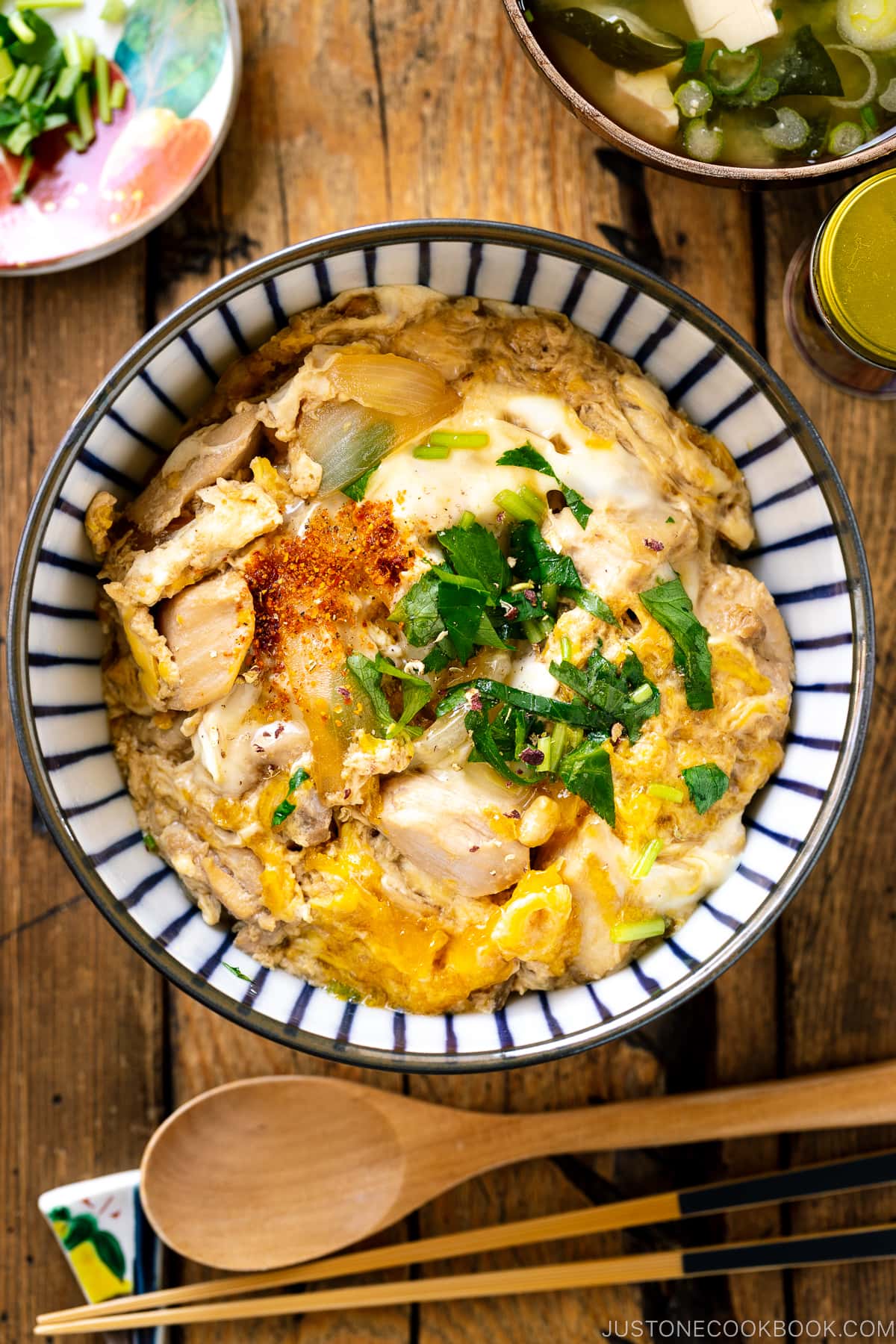
When it comes to mainstream fast food, Japan offers not only hamburgers and french fries, but the menu also extends to noodles and donburi (rice bowl) meals.
During lunchtime, you’d see diners and noodle shops around the office buildings crowded with Japanese office workers making their fuss-free fast food orders. These lunch spots usually serve up quick one-bowl meals, and Oyakodon (親子丼) or Oyako Donburi (親子丼ぶり) is often one of the popular choices.
Today, let’s make this quick and easy Chicken and Egg Rice Bowl at home!
Table of Contents
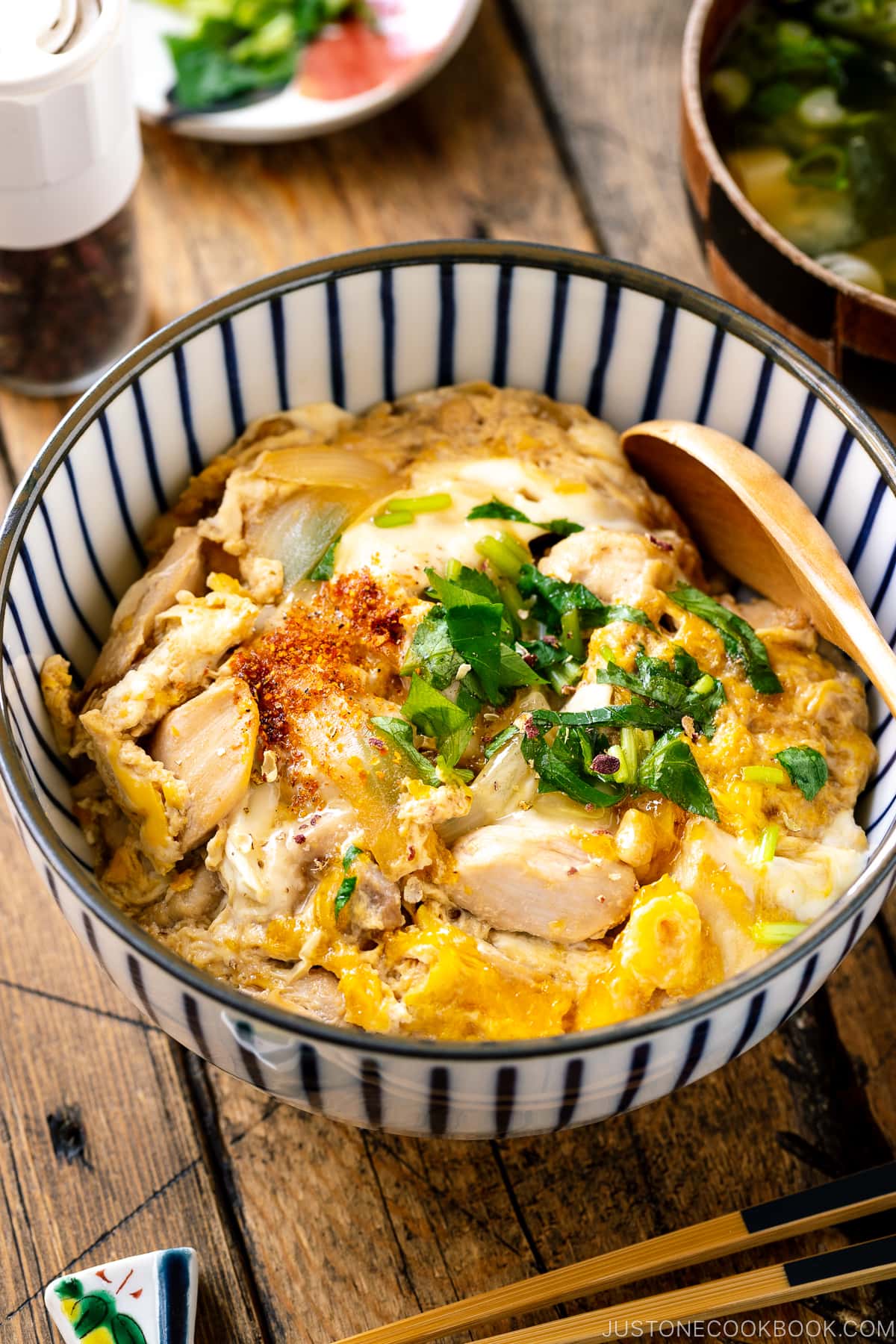
What is Oyakodon?
An epitome of Japanese soul food, oyakodon (親子丼) literally translates to parent-and-child (oya-ko) rice bowl (don) as the dish is composed of chicken and egg.
Bite-size chicken, tender onion, and softly cooked egg are layered and simmered together in a sweet-salty sauce made with dashi, soy sauce, and mirin and served on a bed of steamed rice. The contrast of textures and flavors makes you craving for more bites.
Like Gyudon and Katsudon, oyakodon is not only a long-time restaurant favorite but also a staple dish of Japanese households. Just as the name implies, everything about the rice bowl brings comfort and warmth.
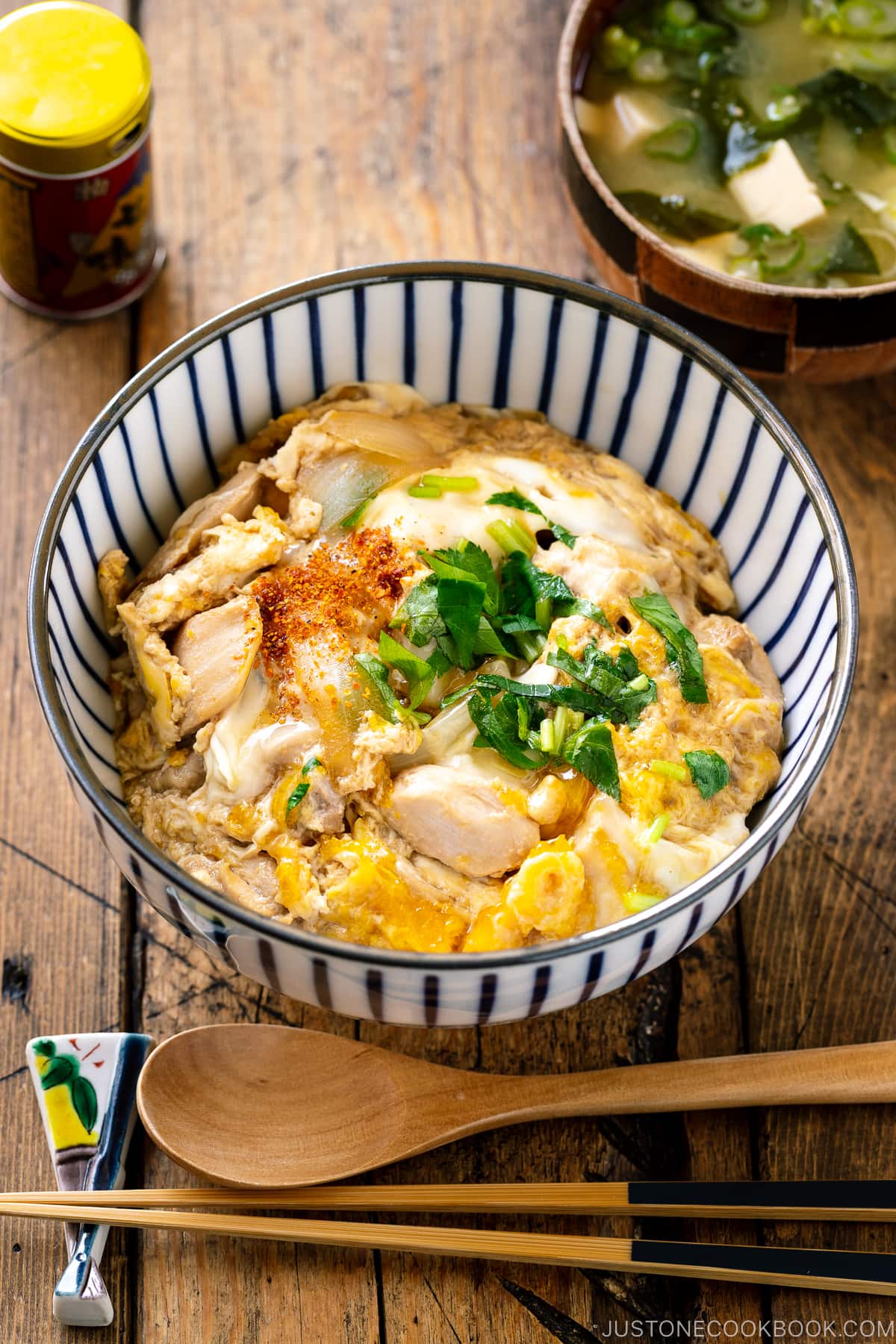
5 Reasons Why You Should Try This Recipe
- One pan and one bowl meal. When thinking of easy weeknight meals, a one-pan and one-bowl meal is an ideal solution. Fewer dishes = easy cleanup!
- Quick and easy 30-minute cooking! This dish can be whipped up with minimal time and effort. I first learned how to cook oyakodon in my home and economics class in middle school. These days, it is still one of my go-to comfort foods. If you have teenagers at home, oyakodon is a great dish they could easily master. It is a survival meal that will sustain them when they go off to college.
- Easy-to-access, pantry-friendly ingredients. Chicken, egg, and onion are standard ingredients in most cuisines. I usually have them handy in my refrigerator (or freezer for chicken). As for the condiments, if you cook Japanese or Asian food often, you most likely have dashi-making ingredients, soy sauce, mirin, and sake.
- No oil! The onions and chicken are simmered in a broth. There’s no frying with oil.
- A satisfying comfort meal at home. You have tender chicken and a soft cooked egg over a fluffy bed of rice. The rice absorbs delicious dashi sauce and every mouthful is sweet-salty-savory. Here you have it: a belly-filling, delicious comfort meal in one bowl.
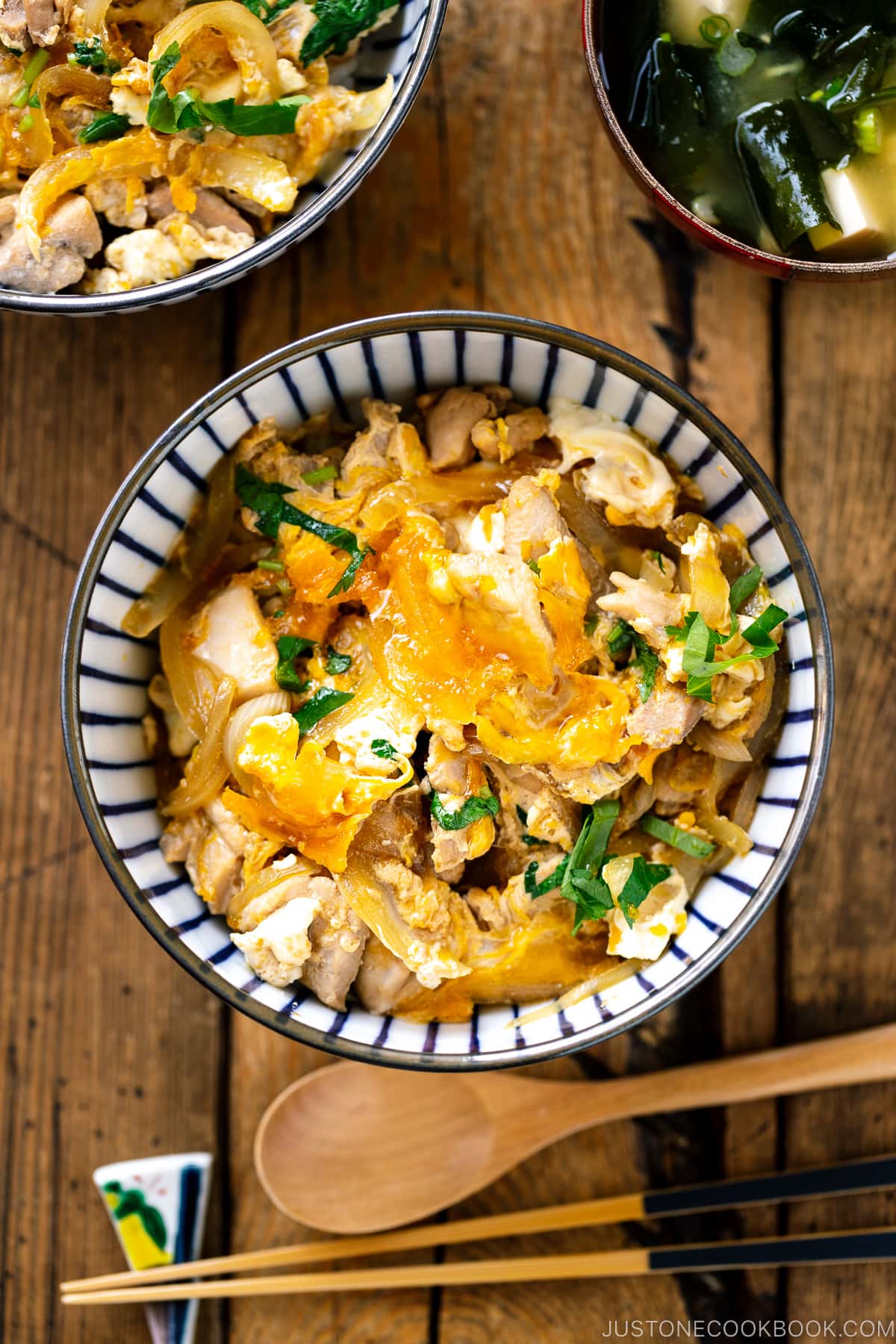
How to Make Oyakodon
Ingredients You’ll Need
- Chicken thighs – I recommend thighs over breasts because fattier thighs are more flavorful, tender, and forgiving (not like dry, overcooked breasts).
- Sake – Drizzling a tablespoon of sake over chicken helps remove its gamey odor.
- Onion
- Eggs
- Mitsuba – This Japanese wild parsley has a celery-like flavor with a slightly bitter taste. Because of its refreshing and unique flavor, the herb is used in many donburi dishes as a garnish. You can substitute it with diagonally thinly sliced green onions.
- Seasonings: Dashi (Japanese soup stock), soy sauce, mirin, and sugar.
- Steamed Rice
- Shichimi togarashi (Japanese seven spice) [optional for spicy kick]
- Sansho pepper powder [optional for fragrance] – It is finely grind peppercorns of the prickly ash tree and has a vibrant peppery-lemon flavor with a long residual heat.
Overview: Cooking Steps
- Prepare the ingredients: Cut the onion, mitsuba/green onions, and chicken and crack the eggs.
- Cook the onion in the seasoning mixture.
- Add the chicken and cook until no longer pink.
- Drizzle egg mixture at two separate times. Garnish mitsuba/green onions.
- Spoon the finished dish over the bed of steamed rice in a donburi bowl.
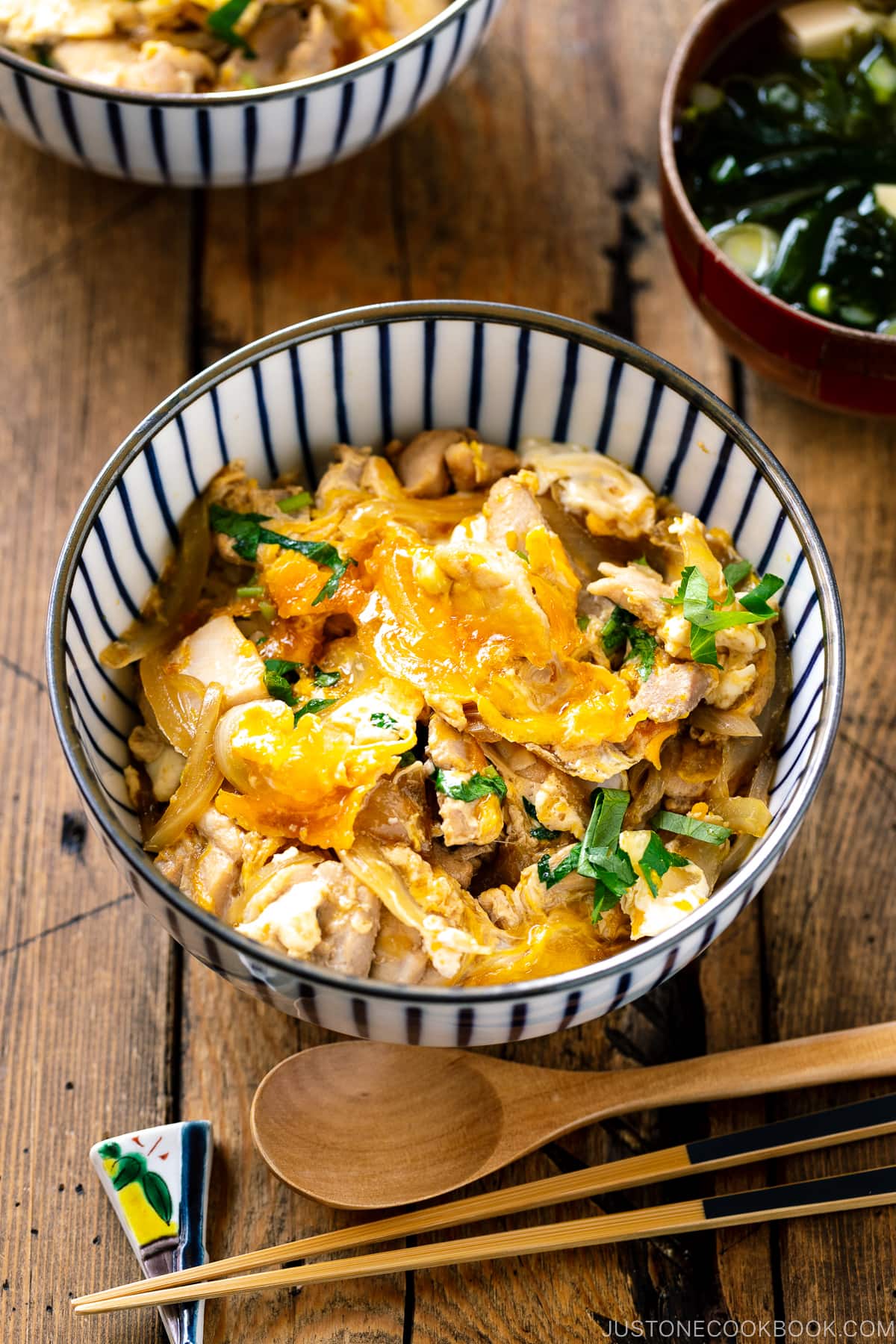
Oyakodon Cooking Tips
Tip 1: Use Good Japanese Soup Stock (Dashi)
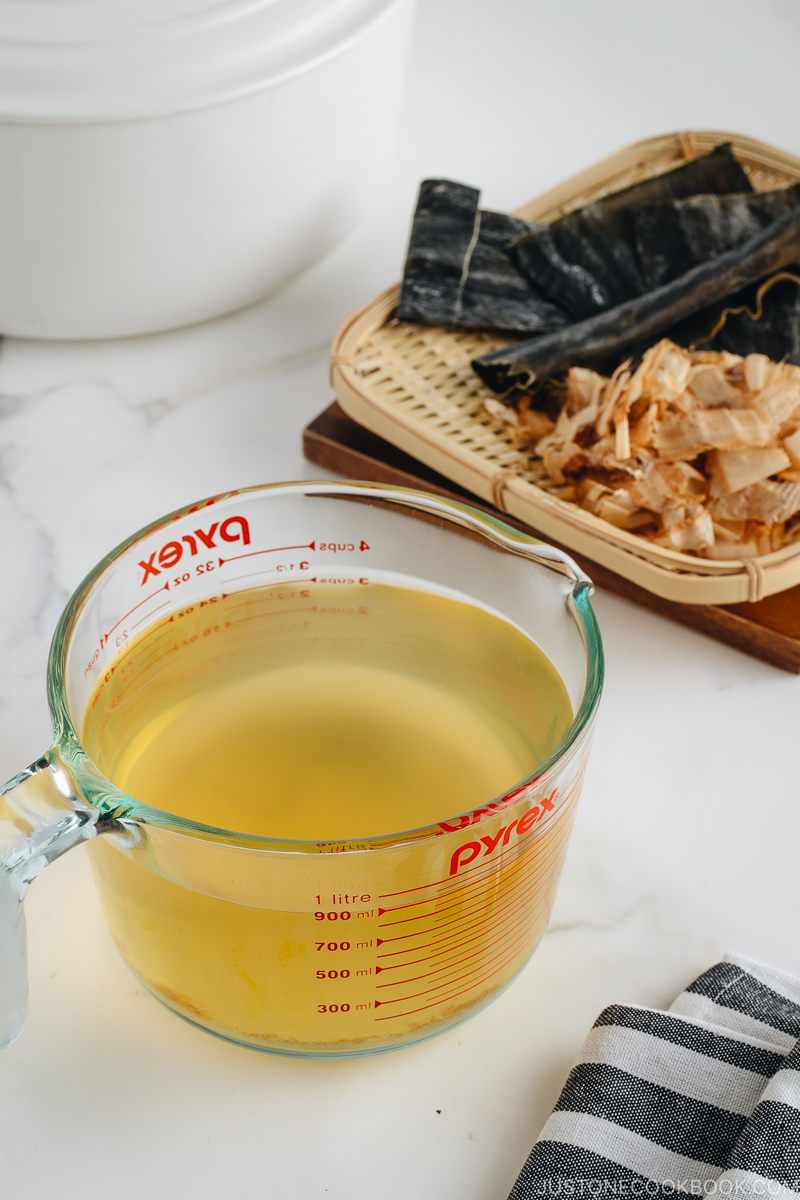
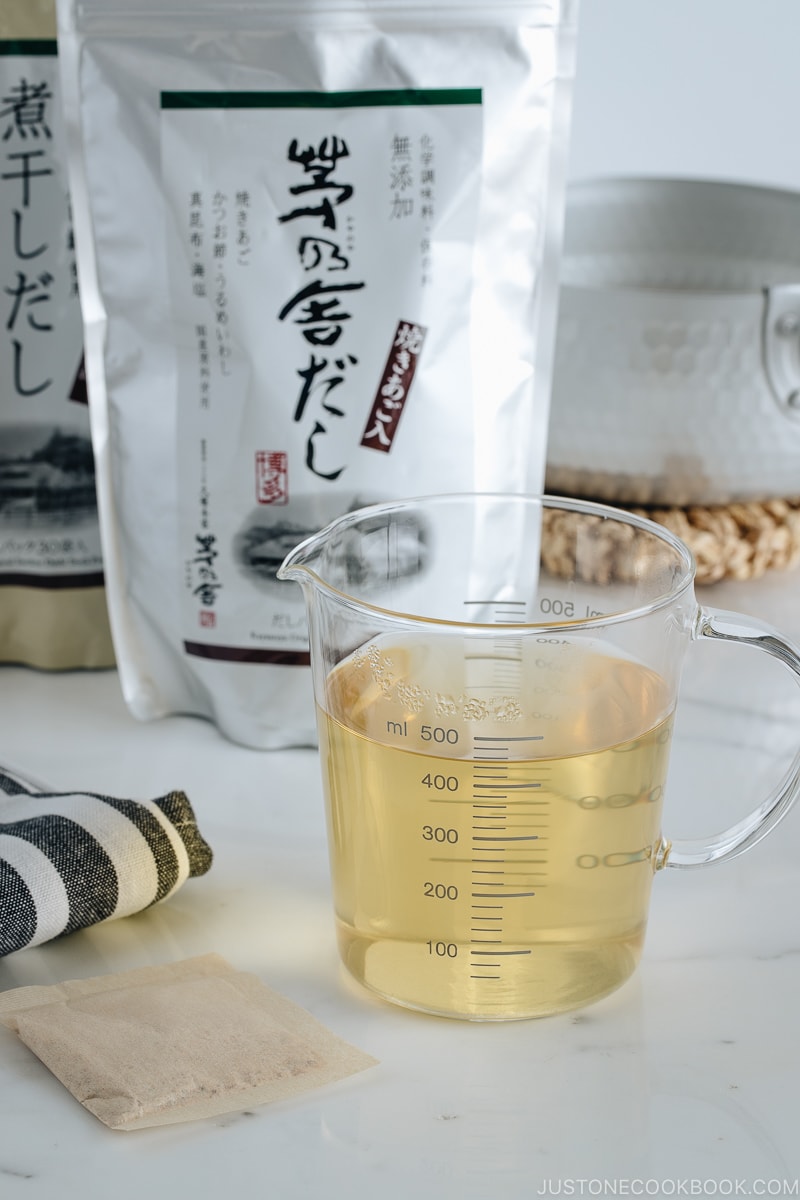
What makes this chicken and egg rice bowl authentically Japanese? It’s the flavor of dashi (Japanese soup stock). If you’re not familiar with dashi, think of this ingredient as the most essential flavor of Japanese cuisine. The good news is:
- It’s so easy to make compared to other stocks; homemade dashi takes 30 minutes.
- It can be vegan-friendly – read Vegan Dashi.
- Dashi can be made instantly with a dashi packet (my preferred method over dashi powder).
I highly recommend reading my Ultimate Dashi Guide as dashi appears in the majority of Japanese recipes and you can’t avoid it.
For two servings, I recommend making a pot of dashi (about 4 cups) and then using ½ cup for Oyakodon and the leftover (3½ cups) for Homemade Miso Soup to serve as a meal set. Now you have a filling rice bowl and a soothing miso soup.
Tip 2: Use the Japanese Cutting Technique “Sogigiri”
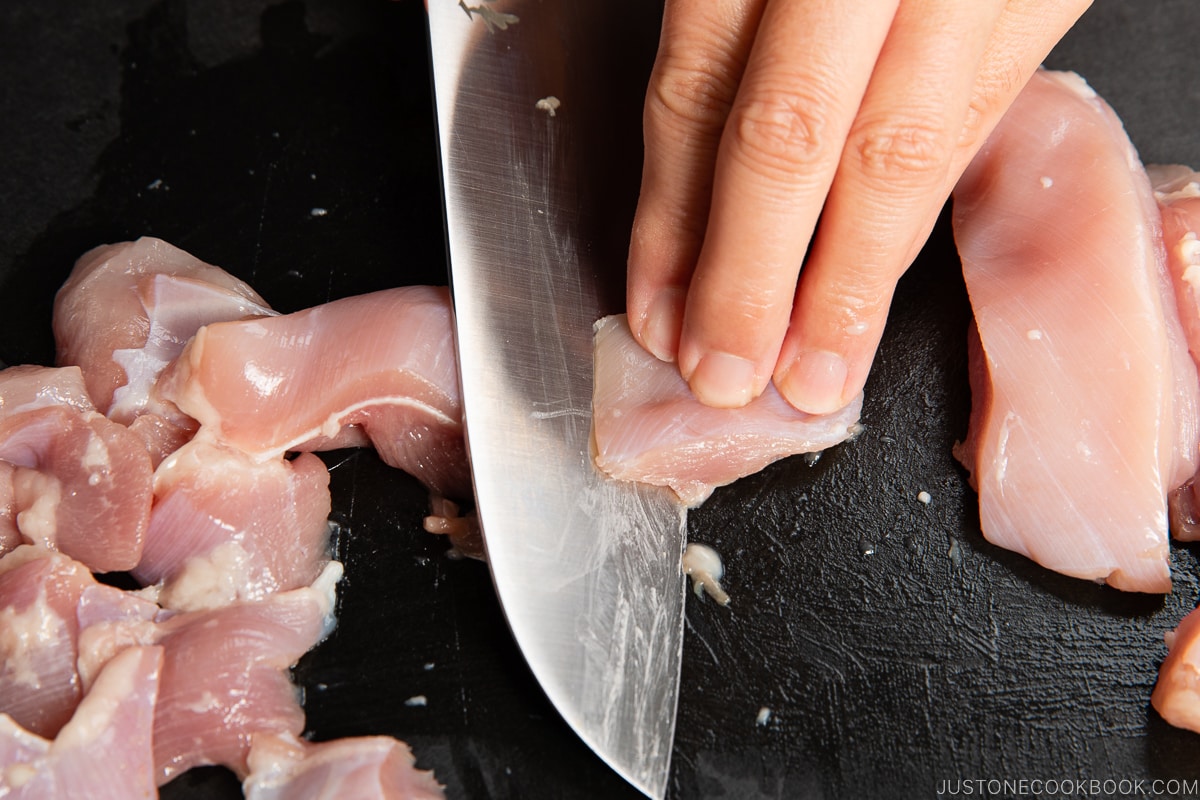
This “sogigiri” cutting technique gives each piece of the ingredient equal thickness and creates more surface area for faster cooking and better absorption of the flavors.
Also, after trying out different sizes of chicken pieces, I realized that cutting the chicken into 2-cm (3/4 inch) pieces worked the best. Big pieces of chicken tend to separate from the rest of the ingredients while smaller pieces are better at incorporating with the onions and soft-cooked eggs.
Tip 3: “Cut” the Egg Whites
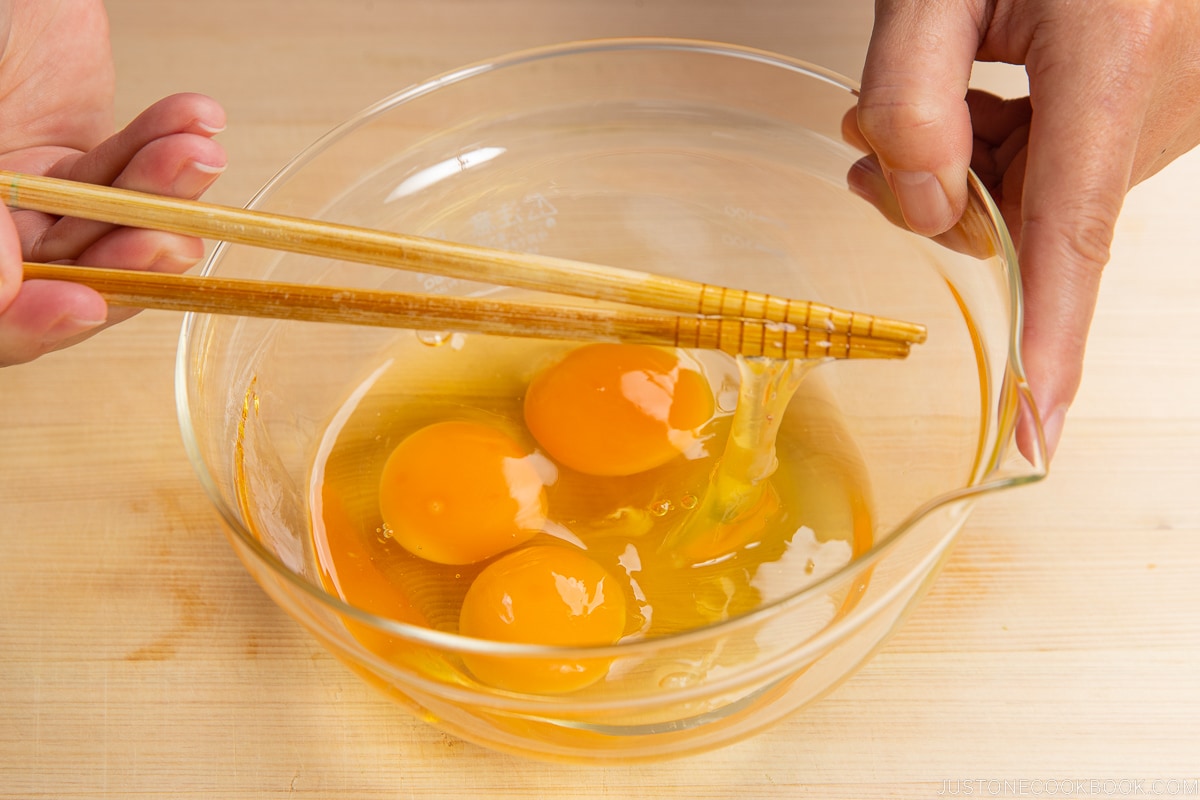
For the best-looking oyakodon, aim for high color contrast between the white and yellow parts of the eggs. That’s why it’s important not to beat the eggs. If you use a beaten egg mixture, you will get one uniform yellow color on your oyakodon.
Instead, “cut” the egg whites 5-6 times with a pair of chopsticks, lifting the whites to break them up into a few smaller clumps. This will prevent the egg whites from falling into the frying pan all at once.
How about the egg yolks? While cutting the egg whites, you may have accidentally broken some of the egg yolks. That’s perfect!
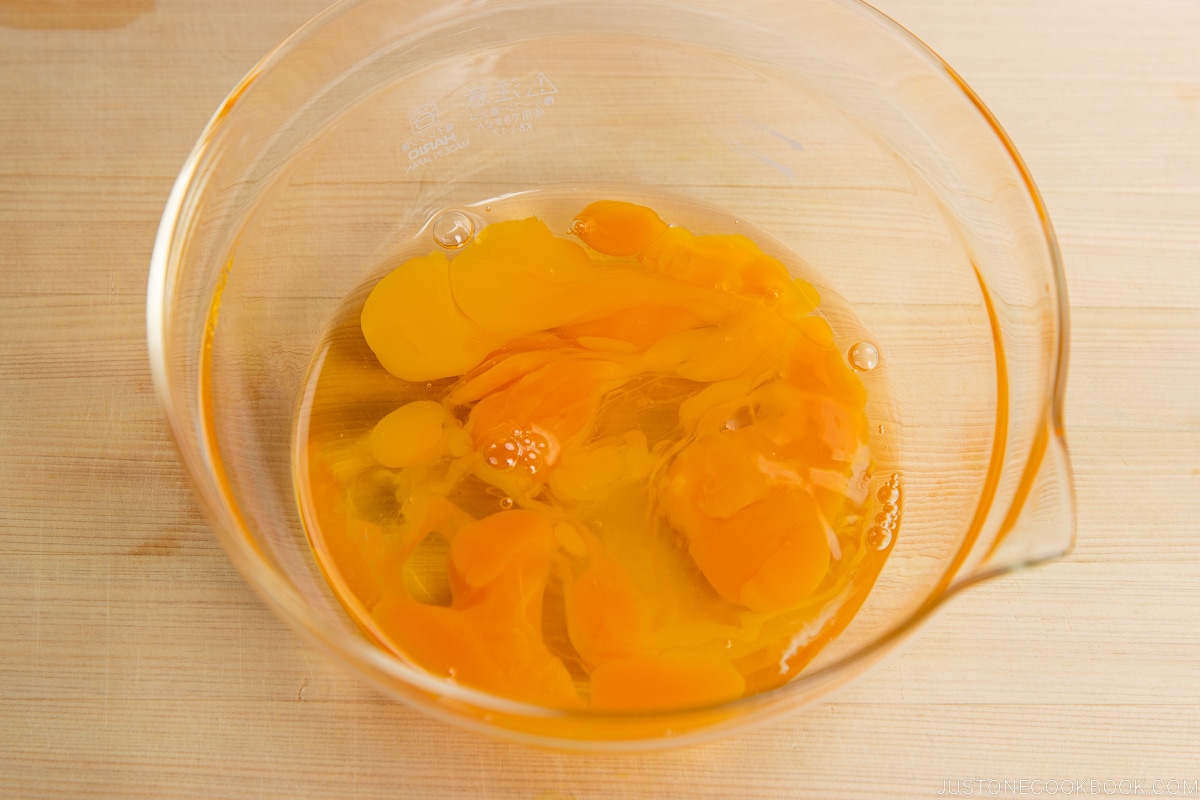
You don’t want to blend the yolks and whites together. If the yolks haven’t broken yet, you can gently break them a little bit. The egg whites and yolks are broken, but still distinct, and they should look like a marble pattern.
Tip 4: Cook a Maximum of Two Servings in One Medium Frying Pan
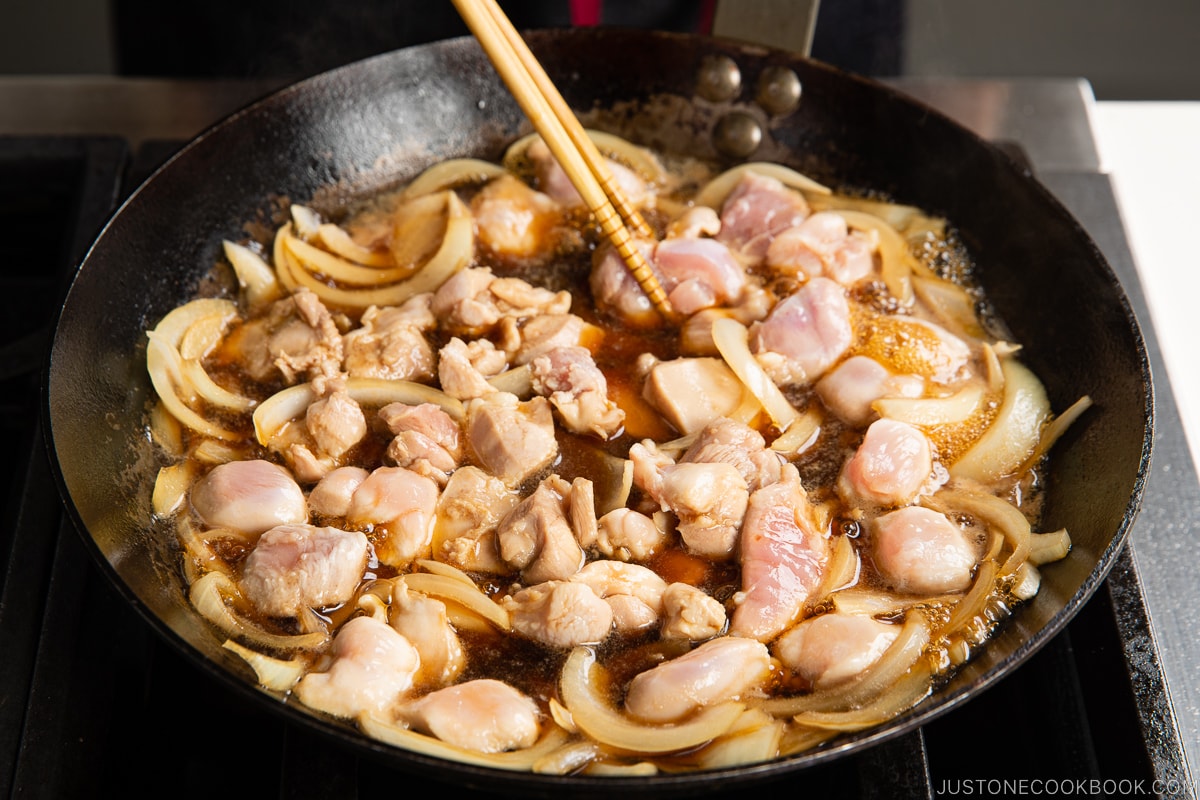
Let’s say you want to multiply the recipe for your family of four or six. The ingredients and seasonings will increase significantly compared to two servings, but the medium frying pan (about 10 inches/25 cm) won’t double or triple in size.
If you try to cook four or six servings in a medium or large frying pan, you will overcrowd the pan and the ingredients will take a long time to cook. Also, the seasonings will not evaporate as efficiently as with two servings. As a result, your oyakodon will have too much sauce, almost like a soup.
Therefore, make two servings per medium frying pan for this recipe. You will need two medium frying pans for four servings.
Tip 5: Add the Eggs at Two Separate Times
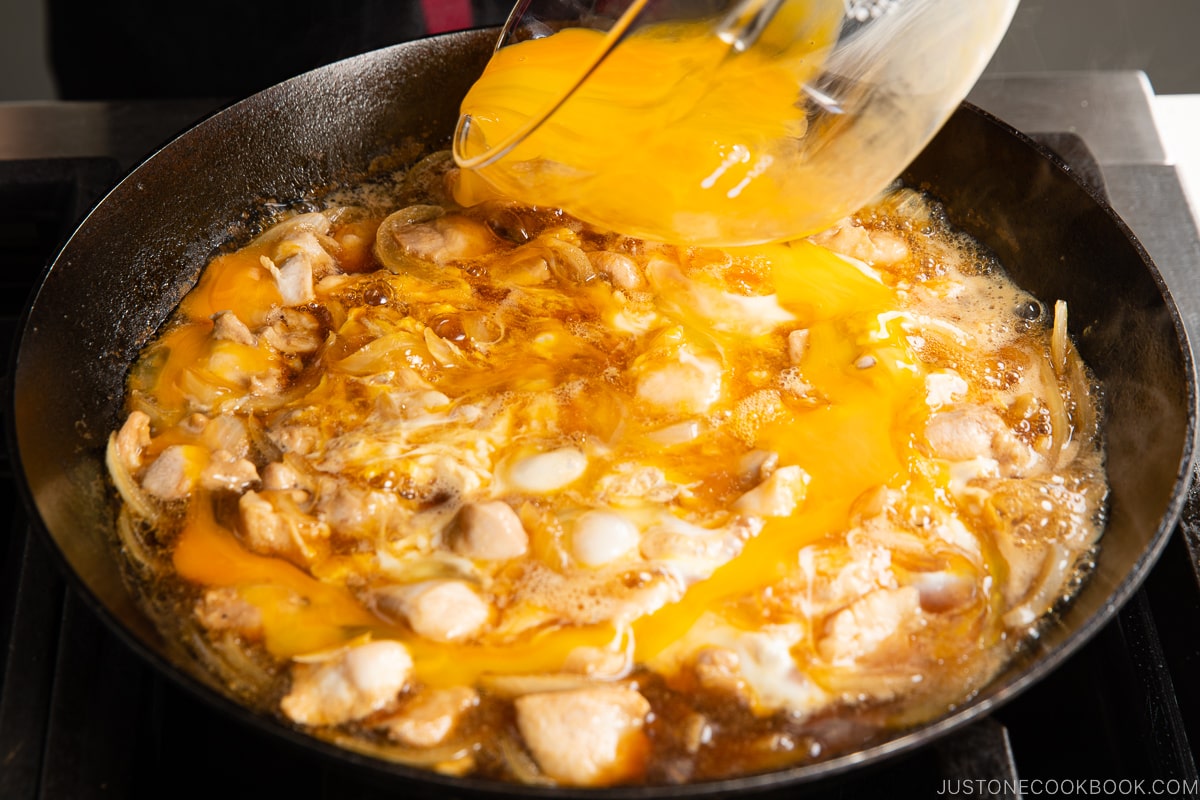
To achieve an ideal egg texture for delicious oyakodon, aim for egg whites that are somewhat firm but still wobbly and egg yolks that remain soft and runny. Since raw eggs are safe to consume in Japan, oyakodon can look a bit different when it’s served in Japan. Don’t be shocked if the eggs are a lot more on the runny and raw side there.
If you live outside of Japan, it’s best to cook the eggs slightly longer than how it’s cooked in Japan. It may not look as pretty, but it’s for food safety reasons.
To achieve the fluffy soft-cooked egg for oyakodon, we add the eggs to the simmering chicken and egg mixture at two separate times:
- Add two-thirds of the eggs (ideally more egg whites because they take longer time to cook than egg yolks) to the center of the pan, avoiding the edges where eggs get overcooked.
- Add the remaining one-third of the eggs (ideally more egg yolks) to the entire surface of the pan.
One last tip! It’s faster to cook egg whites when the eggs are already at room temperature.
FAQs
What is an oyakodon pan?
In Japan, oyakodon is typically made in this single-serving oyakodon pan.
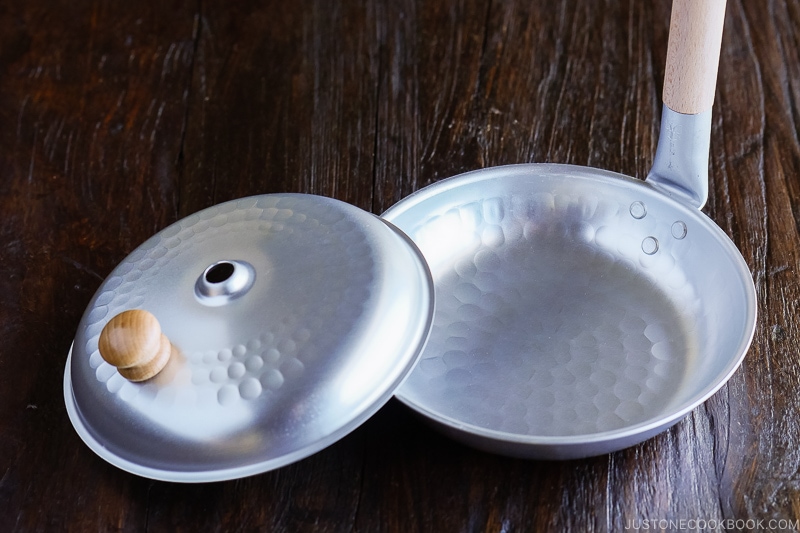
It helps to slide the well-layered dish, including the sauce and soft-cooked egg, into the rice bowl.
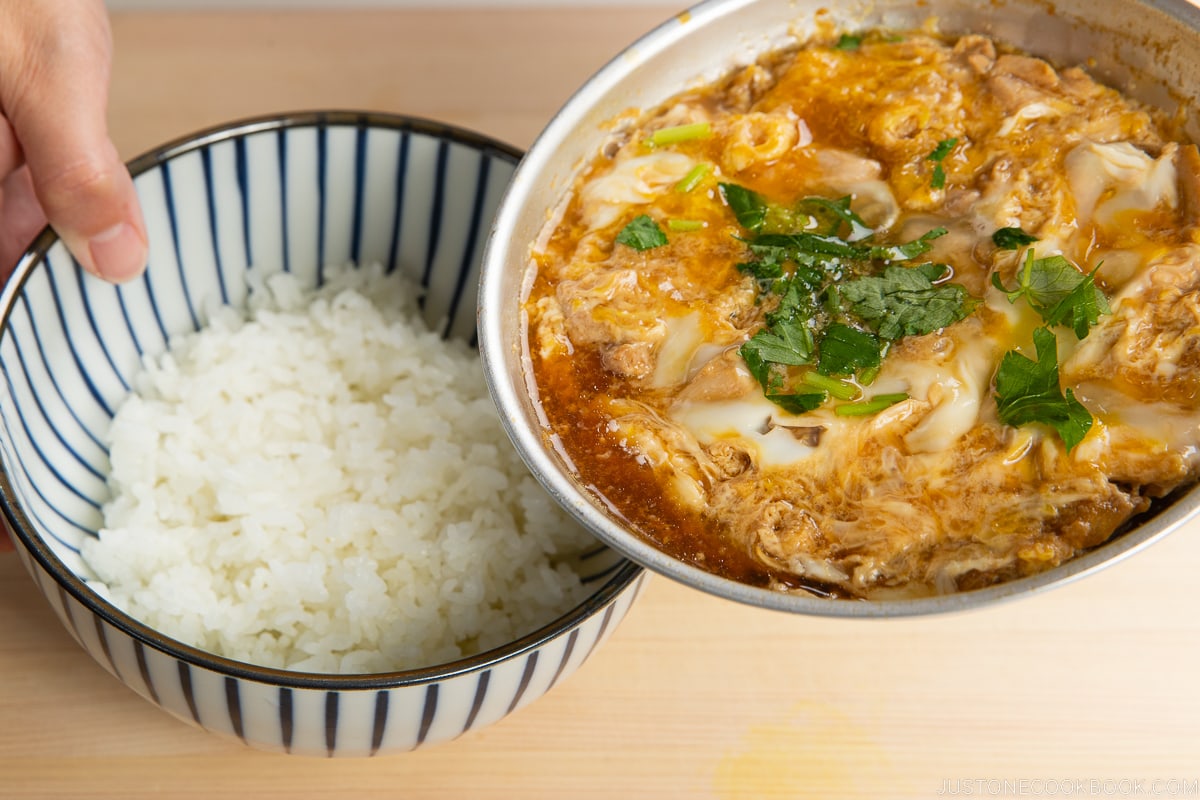
You can use a small shallow frying pan that is slope-sided, so you can easily transfer the chicken and egg mixture to the bed of rice in a donburi bowl. Ideally, the diameter of the pan should be the same or smaller size as your bowl.
Where can I buy an oyakodon pan?
You can find one in the following online stores:
- Amazon
- MTC Kitchen (Use JOC10 for 10% off)
Why do we need to cook oyakodon one serving at a time?
I think it’s best to explain by comparing the two pictures below.


As I explained earlier, when you use an oyakodon pan or a small frying pan, you can slide the entire dish—onion-chicken-egg layer—onto the bed of steamed rice.
When you cook oyakodon in a medium frying pan, you have to scoop out the dish, breaking the layers despite your best attempt. If you have a really wide flat spoon, you may be able to transfer a big portion onto the rice bowl, but it will still not be big enough to cover the rice and the dish will look a little broken up.
Restaurants and some home cooks use the single-serving oyakodon pan just to achieve the proper look of the dish.
Can we use fewer eggs?
The standard number of eggs for oyakodon is 2 eggs per serving. The eggs bind all the other ingredients in the simmering sauce together so that the finished oyakodon can slide onto the bed of steamed rice smoothly.
If you’re cooking for two servings in a medium frying pan, you can use 3 eggs, 1½ eggs per serving. However, I don’t recommend using fewer eggs than that as they won’t be able to bind all the ingredients together.
Can we cover the frying pan with a lid?
I’ve made oyakodon both with and without a lid, testing out the cooking time, flavor, and texture and adjusting the seasoning mixture to achieve the best result.
With a lid on, the chicken will cook slightly faster, but the inside of the pan gets quite hot and the chicken can get overcooked while you want to simmer a bit longer for the chicken to absorb more flavors.
After multiple tests, my final verdict is to cook uncovered. When you cook uncovered, the excess moisture from the onion and chicken will evaporate and the sauce will be more flavorful and intense.
One exception is for cooking the eggs. If you prefer to fully cook the eggs, you may want to use a lid.
More Easy Rice Bowl Recipes
- Gyudon (Quick Beef Bowl)
- Tanin Don (Beef and Egg Rice Bowl)
- Chicken Katsudon
- Pork Curry Bowl
- 12 Donburi Recipes
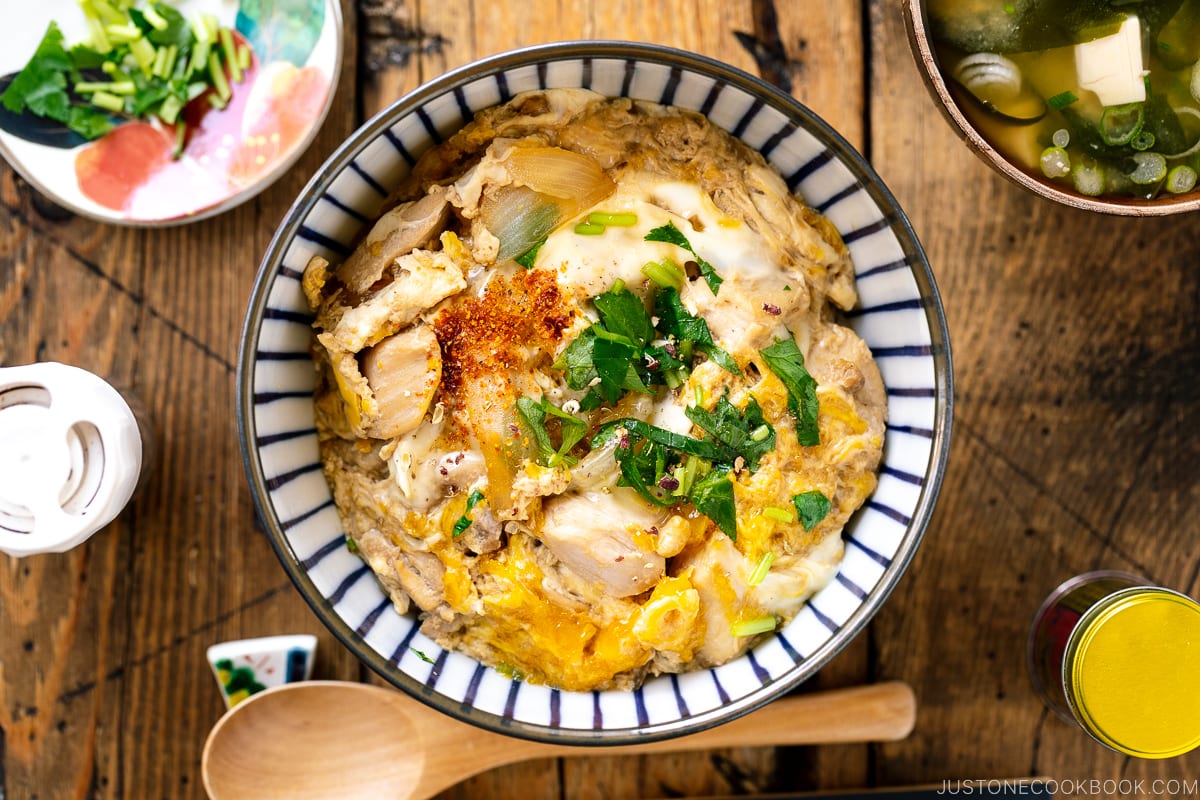
Wish to learn more about Japanese cooking? Sign up for our free newsletter to receive cooking tips & recipe updates! And stay in touch with me on Facebook, Pinterest, YouTube, and Instagram.
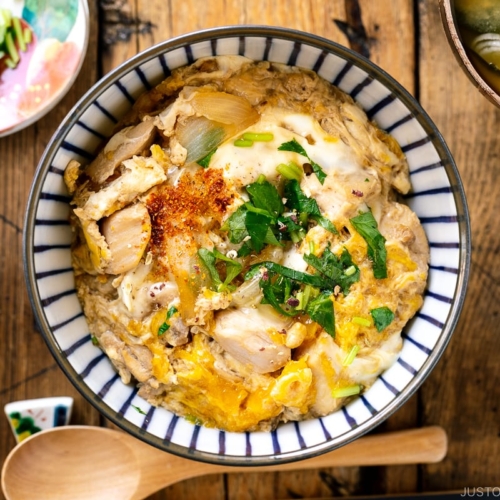
Oyakodon (Chicken and Egg Rice Bowl)
Video
Ingredients
- ½ onion (4 oz, 113 g; peeled)
- 10 oz boneless, skinless chicken thighs (typically 1–2 thighs; use plant-based meat substitute for vegan/vegetarian)
- 1 Tbsp sake (for marinating the chicken; substitute with Chinese rice wine or dry sherry, or omit)
- 3–4 large eggs (50 g each w/o shell) (at room temperature; for vegan/vegetarian, use egg substitute such as JUST Egg)
For the Seasonings
- ½ cup dashi (Japanese soup stock) (use standard Awase Dashi, dashi packet or powder, or Vegan Dashi)
- 2 Tbsp soy sauce
- 2 Tbsp mirin
- 2 tsp sugar
For Serving
- 2 servings cooked Japanese short-grain rice (typically 1⅔ cups (250 g) per donburi serving)
- 4 sprigs mitsuba (Japanese parsley) (or green onion/scallion)
- shichimi togarashi (Japanese seven spice) (optional)
- Japanese sansho pepper (optional)
Instructions
Before You Start…
- For the steamed rice, please note that 1½ cups (300 g, 2 rice cooker cups) of uncooked Japanese short-grain rice yield 4⅓ cups (660 g) of cooked rice, enough for 2 donburi servings (3⅓ cups, 500 g). See how to cook short-grain rice with a rice cooker, pot over the stove, Instant Pot, or donabe.

- This recipe includes both cooking methods—using a medium frying pan (about 10 inches/25 cm) and an oyakodon pan or small frying pan (8 inches/20 cm). Typically, oyakodon is made individually for each serving using an oyakodon pan, which lets you slide the cooked ingredients onto the rice bowl easily. See the separate cooking instructions below.

- Gather all the ingredients. Do not make more than two servings in a medium frying pan. I explained a bit more in the blog post (under Oyakodon Cooking Tips). If you are making four servings, use two medium frying pans.

To Prepare the Seasonings
- Combine ½ cup dashi (Japanese soup stock), 2 Tbsp soy sauce, 2 Tbsp mirin, and 2 tsp sugar in a bowl or a liquid measuring cup and mix all together until the sugar is dissolved.

To Prepare the Ingredients
- Slice ½ onion lengthwise, about ¼ inch (6 mm) wide.

- Chop 4 sprigs mitsuba (Japanese parsley) ½ inch (1.3 cm) wide.

- Trim the extra bits of fat and connective tissue from 10 oz boneless, skinless chicken thighs with the knife.

- Cut the chicken thigh along the grain into strips ¾–1 inch (2–2.5 cm) wide. Next, angle your knife back and diagonally (nearly parallel to the cutting board), and then slice the chicken strips against the grain into pieces about ¾–1 inch (2–2.5 cm) square. This sogigiri cutting technique gives the chicken pieces equal thickness and creates more surface area for fast cooking and better absorption of the flavors.

- Transfer the chicken to a bowl or tray and sprinkle with 1 Tbsp sake. Set aside for 5 minutes.

- Crack 3–4 large eggs (50 g each w/o shell) into a bowl. Using a pair of chopsticks, lift the egg whites to “cut“ them 5–6 times into a few smaller clumps. This will prevent the egg whites from falling into the frying pan all at once. Do not whisk or beat the eggs together. Tip: Aim for high color contrast between the white and yellow parts of the eggs in your finished dish.

- While “cutting“ the egg whites, you may have accidentally broken some of the egg yolks. That‘s okay. If the yolks haven‘t broken yet, you can poke them to gently break them, but do not blend the egg whites and yolks. The eggs should resemble a marble pattern.

To Cook the Oyakodon in a Medium Frying Pan
- With the stove off, add the sliced onions to a medium frying pan (I use a well-seasoned 11” carbon steel pan) in a single layer. Then, add the seasonings mixture. It should just cover the onions. If not, your frying pan is too big and you need to either increase the seasoning or use a smaller pan.

- Turn on the heat to medium and bring it to a simmer. Once simmering, add the chicken on top of the onions.

- Make sure the onions and chicken are evenly distributed. Once simmering again, lower the heat to medium low. Cook, uncovered, for 5 minutes or until the chicken is no longer pink and the onions are tender. Halfway through, flip the chicken. Tip: Evaporation reduces the sauce and intensifies the flavor.

- We will add the eggs in two stages: Two-thirds of the eggs first, then the remaining one-third later. Now, increase the heat to medium. With the cooking liquid simmering (small bubbles around the edges), drizzle two-thirds of the eggs in a circular pattern over the chicken and onions, avoiding the edges of the pan where the eggs can easily overcook. Tip: Only drizzle the eggs if the cooking liquid is simmering, as with Egg Drop Soup. Also, try to add more egg whites at this stage, as the whites take longer to cook than the yolks. Ideally, we want to keep the yolks soft and runny for the final presentation.

- If the heat is too strong, lower the heat. If the egg is moving toward the edges of the pan, gently gather it toward the center where the heat is not as strong. Optionally, you can cover the pan if the egg whites are taking a long time to set.

- When the eggs are still runny but just set, add the rest of the eggs to the center and around the edges of the pan. Add the mitsuba (or green onion) on top and cook on medium low until the egg is done to your liking. Usually, oyakodon in Japan is served while the egg is almost set but still runny (raw eggs are safe to consume in Japan). Tip: For the remaining one-third of the egg, try to distribute more egg yolks so the oyakodon will have a bright yellow color on top. For a good presentation, you can add a beaten extra yolk at the end.

- Serve steamed rice in individual serving bowls. Spoon the cooked chicken and egg mixture onto the steamed rice and drizzle the desired amount of pan sauce on top.

To Cook the Oyakodon in an Oyakodon Pan or a Small Frying Pan
- Cook the chicken and egg in two batches, one serving at a time. Make sure to divide the ingredients in half. With the stove off, add half of the sliced onions to the pan in a single layer. Add half of the seasonings mixture (it should just cover the onions).

- Turn on the heat to medium and bring it to a simmer. Once simmering, add half of the chicken on top of the onions.

- Make sure the onions and chicken are evenly distributed. Once simmering, lower the heat to medium low. Cook, uncovered, for 4 minutes or until the chicken is no longer pink and the onions are tender. Halfway through, flip the chicken. Tip: Evaporation helps to reduce the sauce and intensify the flavor.

- We will add the eggs in two stages: Two-thirds of the eggs first, then the remaining one-third later. Now, increase the heat to medium. With the cooking liquid simmering (small bubbles around the edges), drizzle two-thirds of the eggs in a circular pattern over the chicken and onions, avoiding the edges of the pan where the eggs can easily overcook. Tip: Only add the eggs if the cooking liquid is simmering, as with Egg Drop Soup. Also, try to add more egg whites at this stage, as the whites take longer to cook than the yolks. Ideally, we want to keep the yolks soft and runny for the final presentation.

- When the eggs are still runny but just set, add the rest of the eggs to the center and around the edges of the pan. Add the mitsuba (or green onion) on top and cook on medium low until the egg is done to your liking. Usually, oyakodon in Japan is served while the egg is almost set but still runny (raw eggs are safe to consume in Japan). Tip: For the remaining one-third of the egg, try to distribute the egg yolk so the oyakodon will have a bright yellow color on top. For a good presentation, you can add a beaten extra yolk at the end.

- Portion 2 servings cooked Japanese short-grain rice into individual donburi or other serving bowls. Slide the cooked chicken and egg mixture onto the steamed rice and drizzle the desired amount of pan sauce on top. Repeat Steps 1 to 6 with the remaining ingredients.

To Serve
- Serve the Oyakodon with optional shichimi togarashi (Japanese seven spice) for a spicy kick and Japanese sansho pepper for a peppery fragrance on the side.

To Store
- You can keep the leftovers in an airtight container and store in the refrigerator for up to 2–3 days. To store in the freezer, do not add the eggs. You can add eggs after you reheat it in the pan.
Nutrition
Editor’s Note: The post was originally published on February 4, 2011. It has been republished with new images, updated content, and a revised recipe on October 30, 2022.
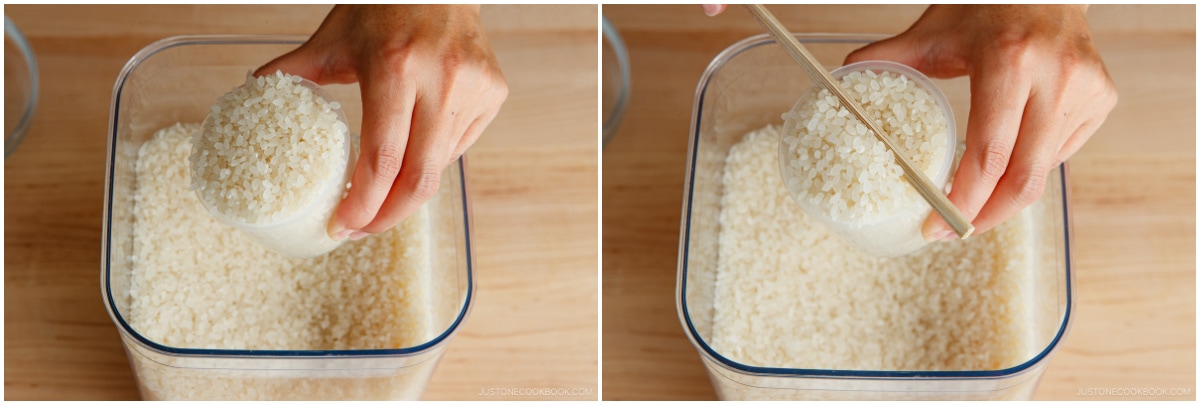
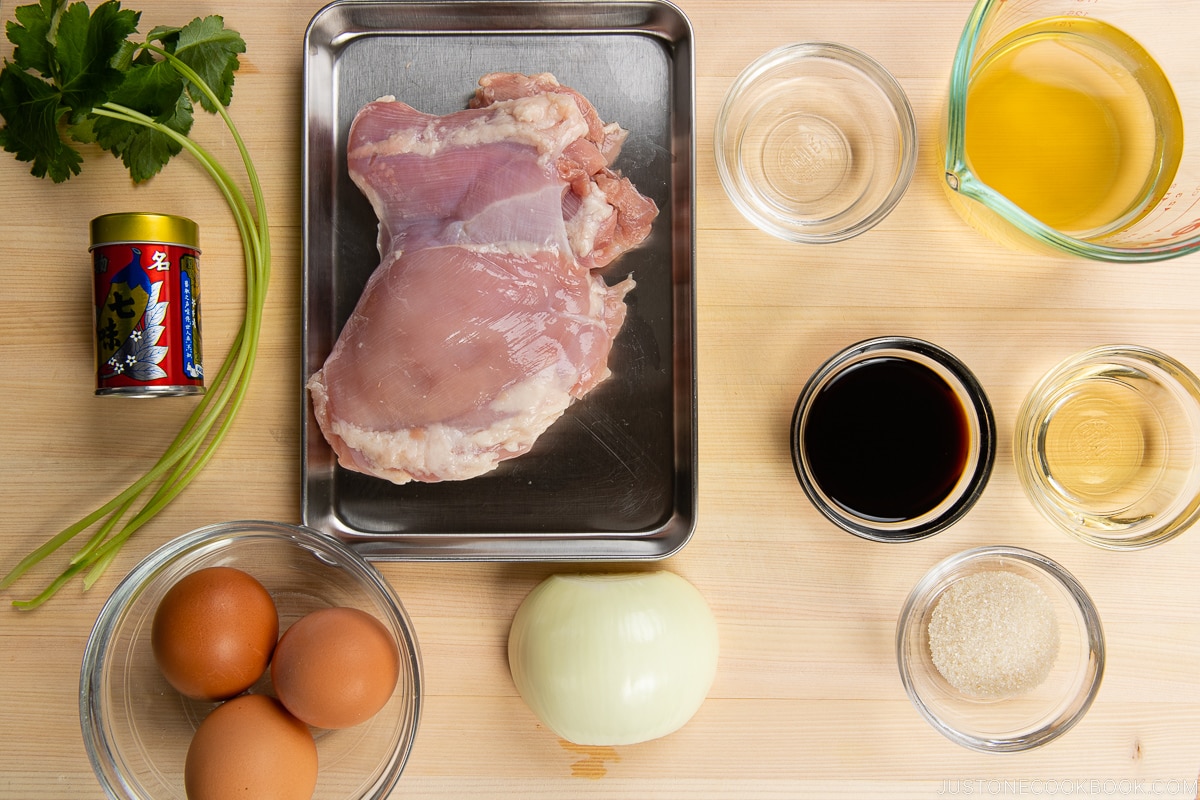
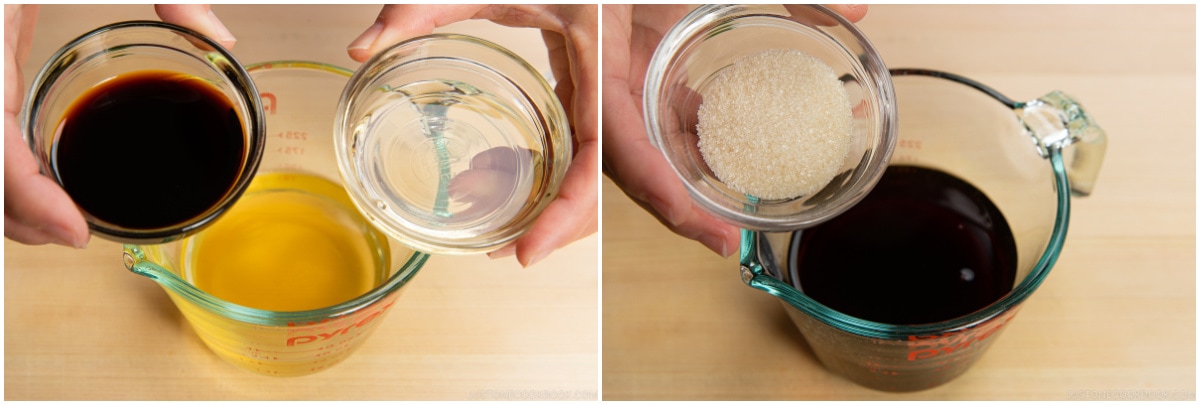
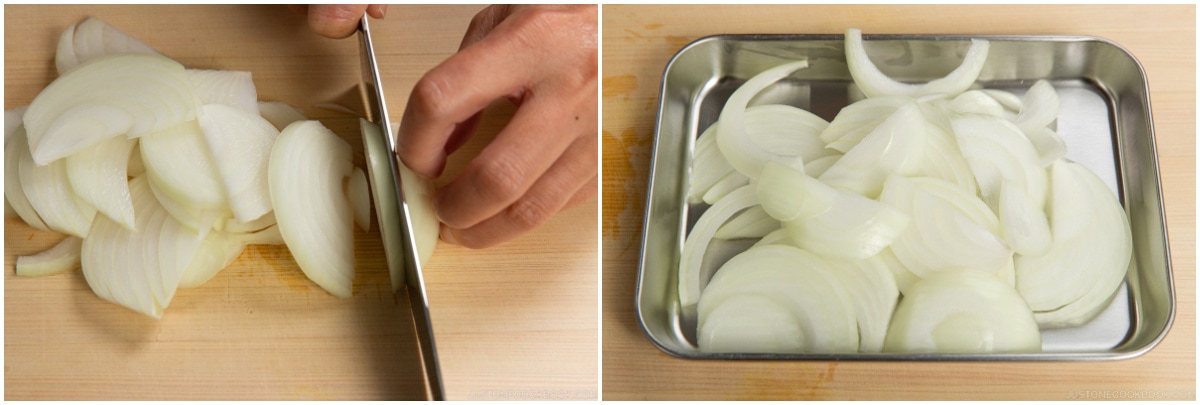
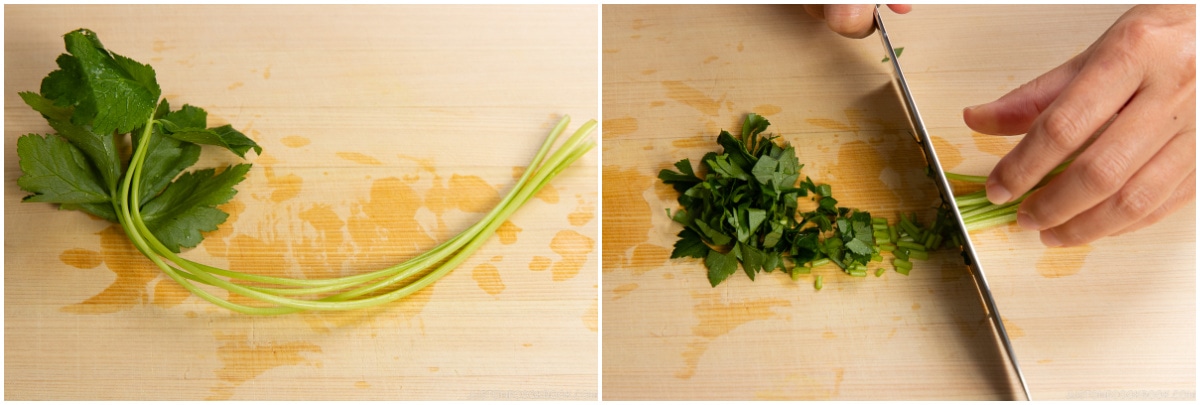
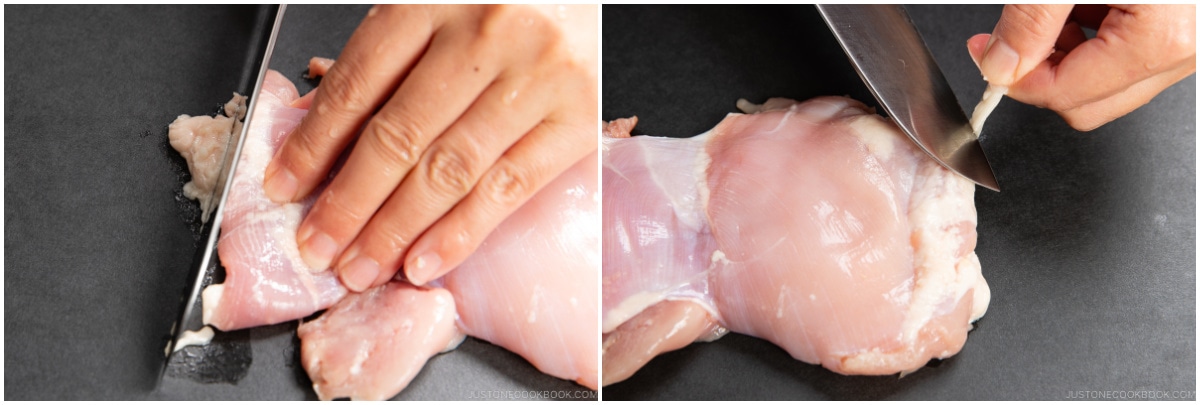
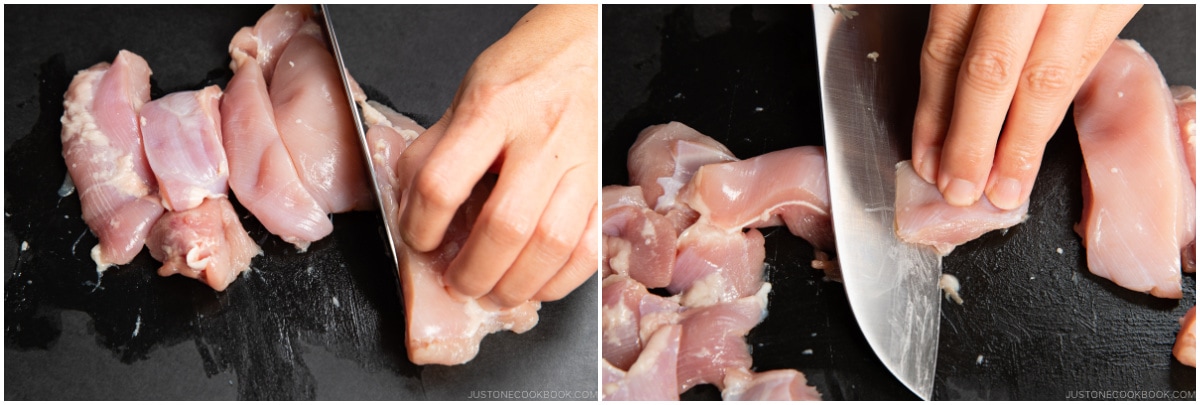
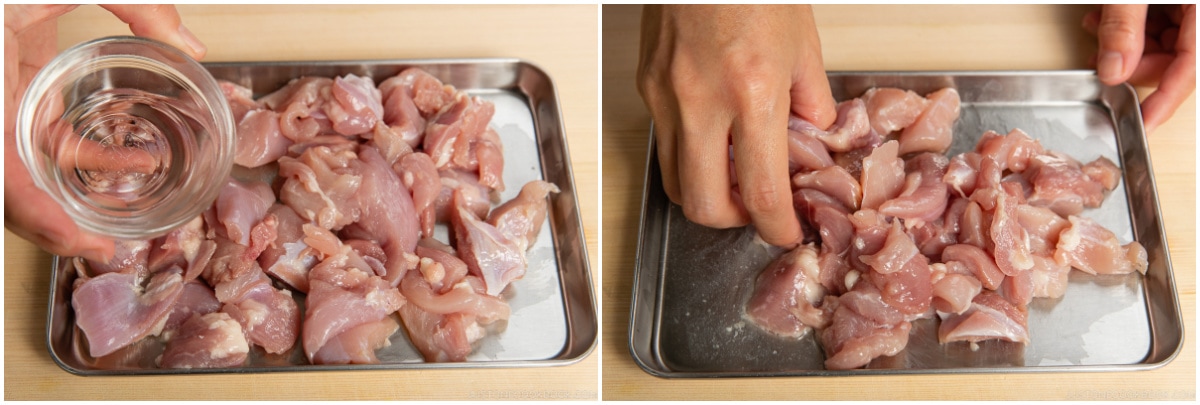
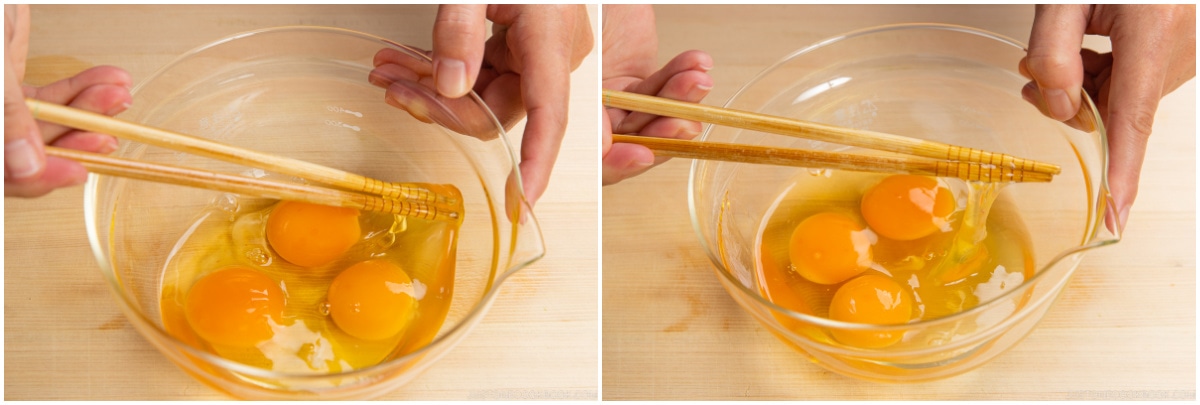
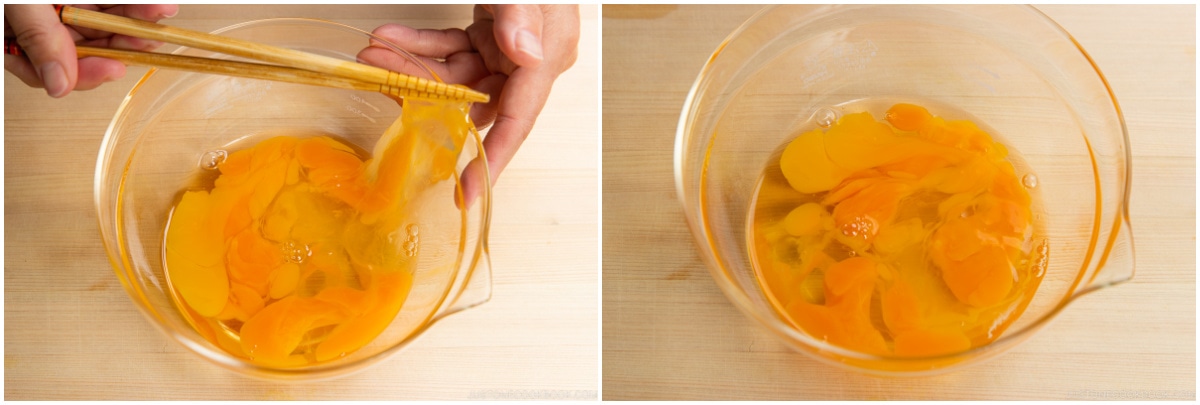
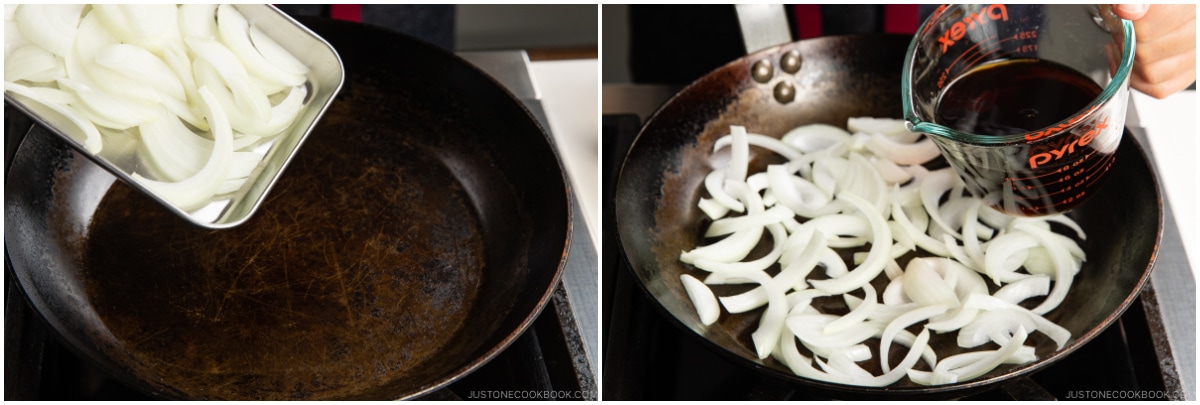
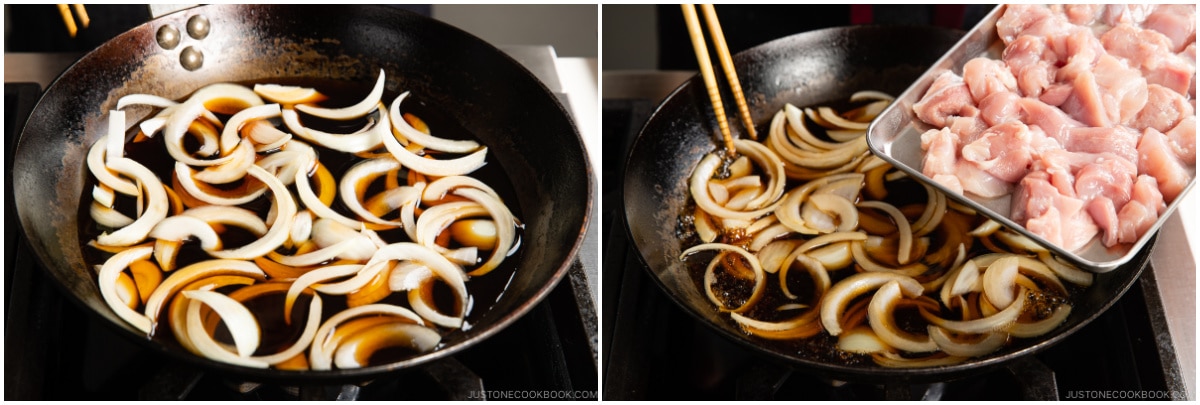
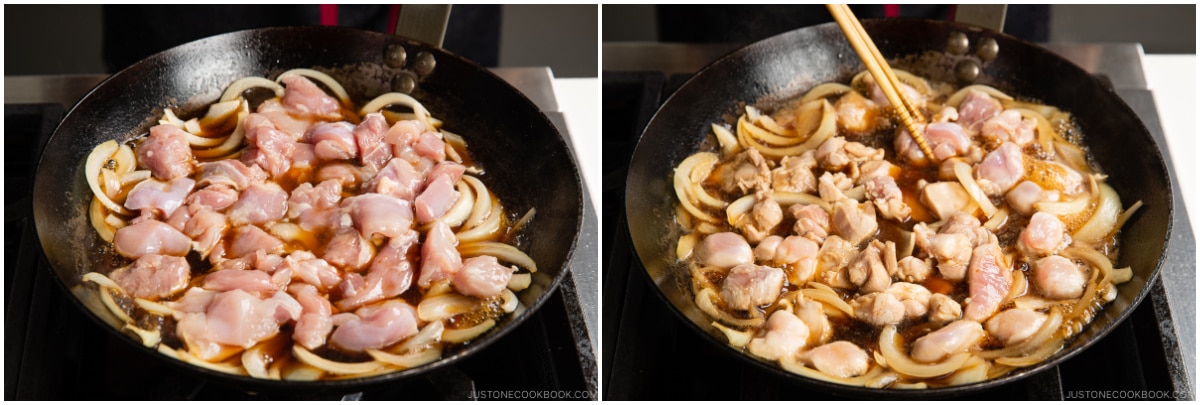
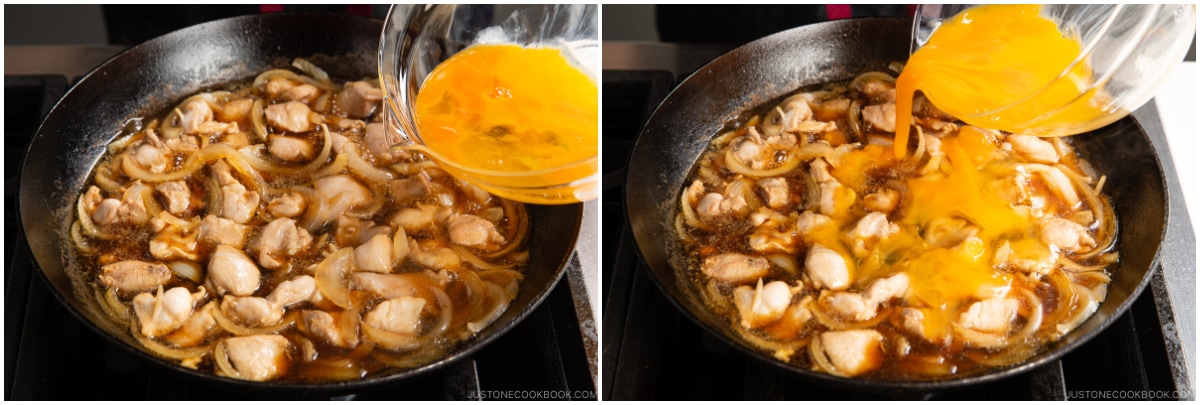
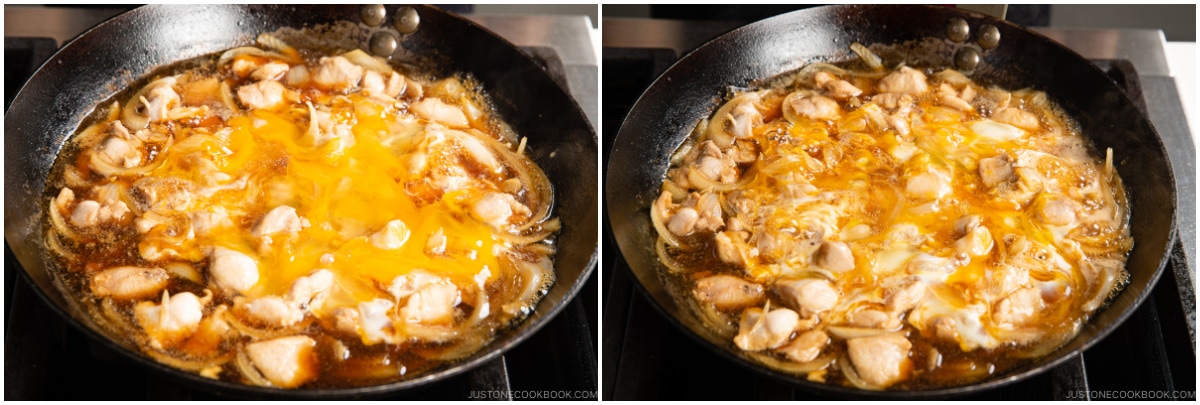
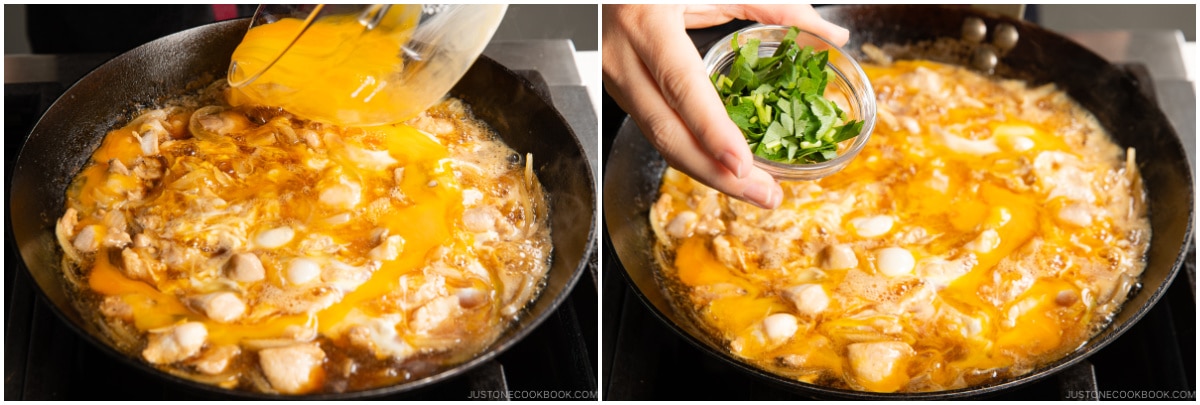
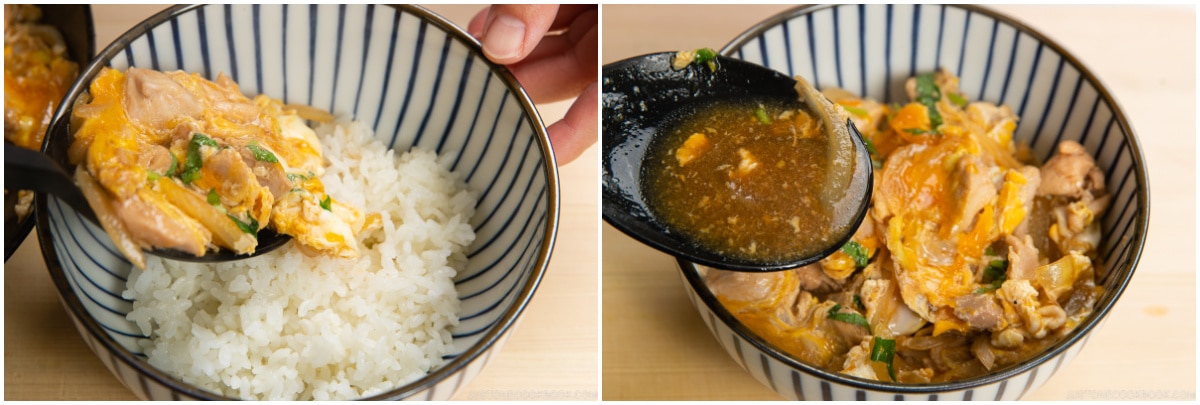
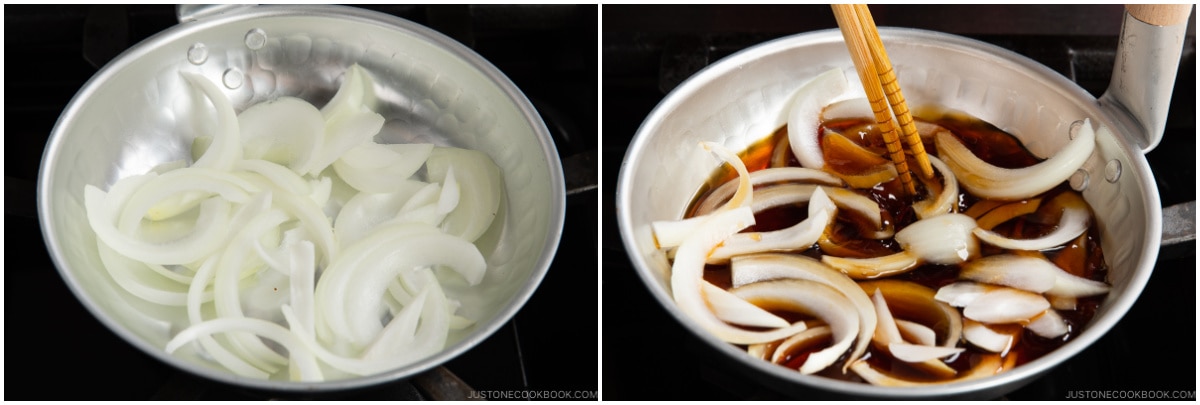
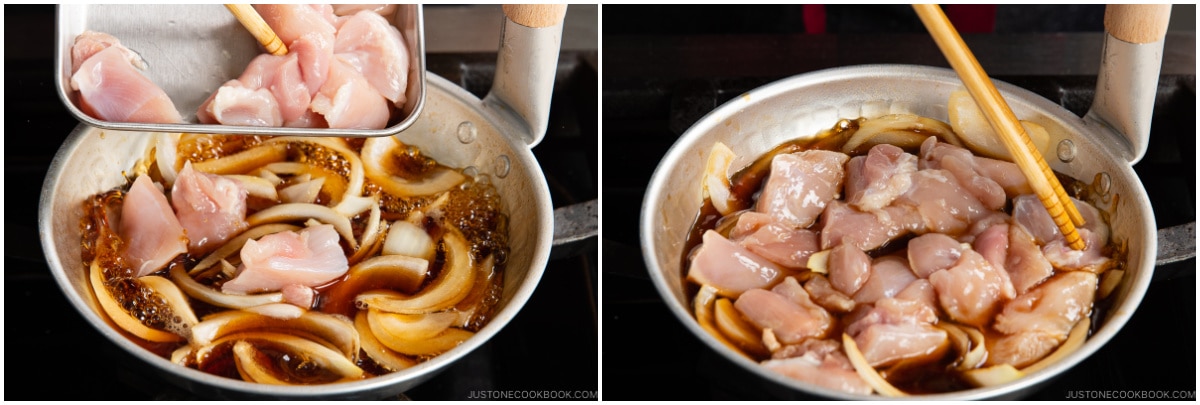
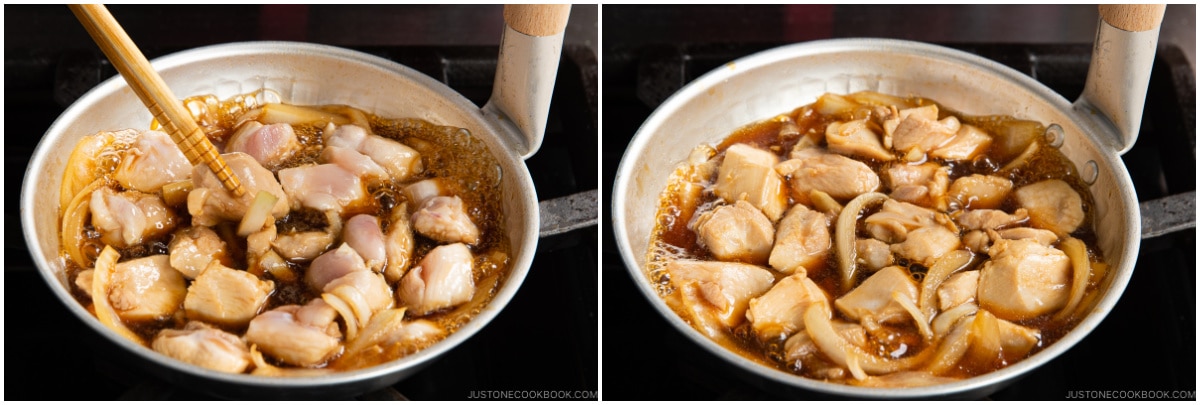
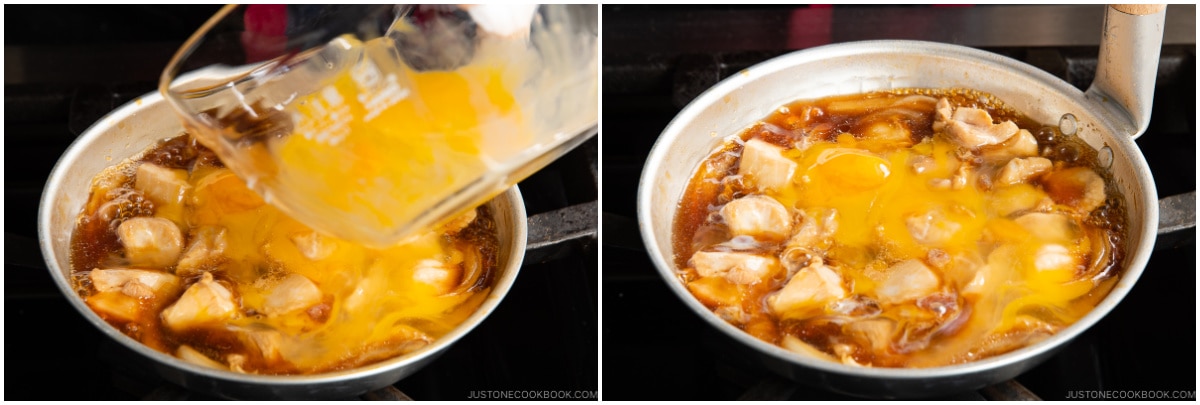
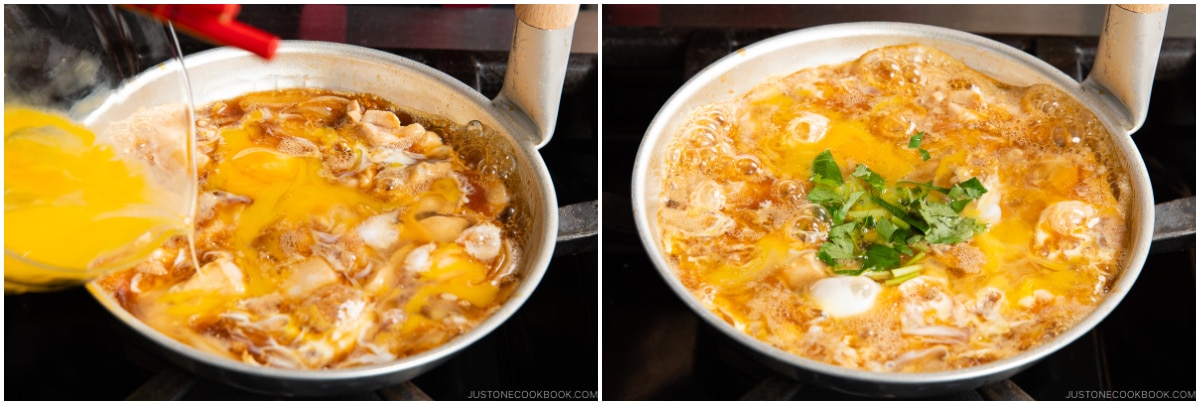
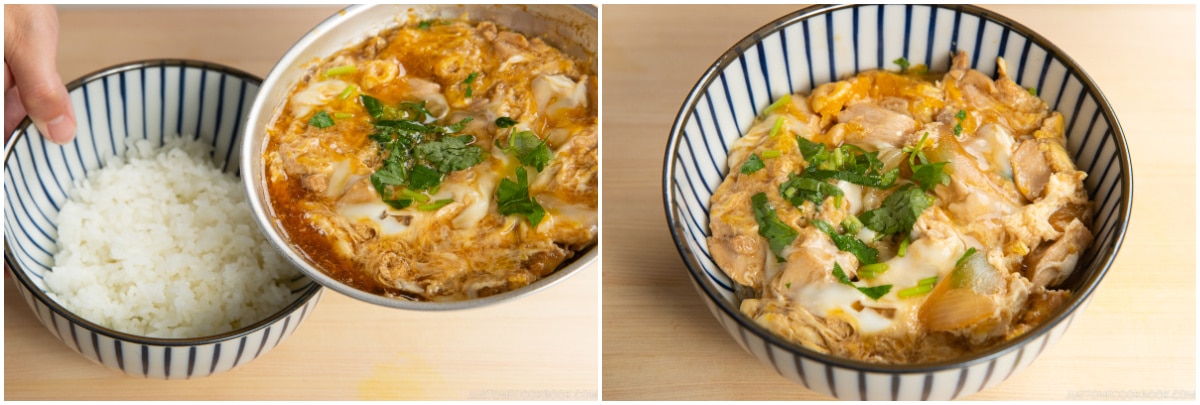










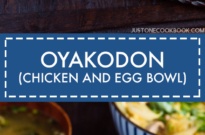
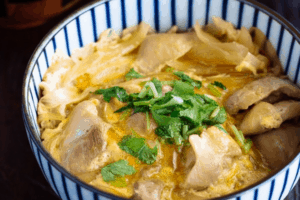
Quick and easy comfort food. Worth making your own Dashi too. Your recipes are easy to follow – thanks for sharing. X
Hi Tania! Thank you so much for trying Nami’s recipe and for your kind feedback!
We are so happy to hear Nami’s recipe was easy to follow. Happy Cooking!
New family favorite! Super simple with a nice short ingredient list. My family had such a great time with the challenge, we each decided on a different recipe and took turns cooking dinner!
Hi Shani! WOW! Thank you so much for trying Nami’s recipe and sharing your cooking challenge story and Oyakodon photo with us! What a terrific idea to take turns cooking meals! This is really motivating.🤩
First time making this Oyakodon recipe, but what an awesome bowl of chicken and egg this was though! The Makanai movie and Nami’s detailed and easy to follow recipe really inspired me to make this quick, easy and healthy rice bowl 🙂
Hello, Abbie! Thank you very much for reading Nami’s post and trying her recipes.
Nami and all of us at JOC were touched by your kind remarks. Thank you for taking the time to send us a photo of your delicious Oyakodon.
Happy Cooking!
This oyakodon recipe was easy and fast, delicious, and warming: comfort food at its best! I made it twice. The first time, I mixed the eggs as directed in the recipe, gently breaking the yolks before adding two thirds to the chicken and egg mixture and then the remainder. I had a hard time adding mostly the egg whites! The second time I made the recipe, I didn’t break the egg yolks until after I added the egg whites. I felt like the results had a nicer presentation, with the yellow egg yolk color on top. Either way, it was delicious! Thanks for a great recipe!
My photo didn’t appear with my original comment, but here it is.
Hello, Sandra! Thank you for retrying and attaching your Oyakodon picture! That looks delicious!
Thank you for trying Nami’s recipe and sharing your culinary experience.💞
This is one of my favorite recipes. I use your recipes at least twice a week! So many great options. Thank you so much for sharing
Hi Nicole! Wow!🥰 We are so happy to hear you enjoyed the Oyakodon recipe very much!
Thank you so much for trying Nami’s recipe and for your kind feedback. Happy Cooking!
Very fast and easy recipe! I like to buy packs of chicken thighs, chop them up, then freeze them in single portions. That way I can just pull out one pre-chopped chicken thigh from the freezer to make this whenever I’m craving it.
Hi Julia! Thank you so much for trying Nami’s recipe and sharing your tip and Oyakodon photo with us! 🤗
I regularly make Nami’s recipes but this is a staple weekday dinner in my household! It makes me miffed to know how much they can charge for a bowl of this in a very sub-par Japanese restaurant where I live, when you can make it so easily, so much tastier (and probably healthier!) at home. Another easy-to-follow JOC recipe and would highly recommend!
Hi Olivia! Thank you so much for trying Nami’s recipes and for your kind feedback!
We are so happy to hear you have been enjoying Nami’s recipe and that Oyakodon has become your staple weekday dinner. Thank you for sharing your photo with us!
Hello, Olivia! Thank you so much for trying Nami’s recipe and for your feedback!
We are happy to see your Oyakodon photo and learn that this was a simple recipe. 😊
Thank you for inspiring others to try!
Happy cooking!
This oyakodon was sooo delicious! Thank you for sharing this comforting recipe. Making and eating oyakodon tonight made me so happy at a time when I really need it. Next time I’ll have to try making my own dashi instead. 🙂
Hi Jenn, Aww. 🥹 Thank you so much for trying Nami’s recipe and for your kind feedback!
We are so happy to hear that you enjoyed homemade Oyakodon.
I love oyakodon so much I made it 5 (maybe more) times in two months since I started making recipes from this page (and I’ve made 24 different recipes so far). I also made it for the Makanai cooking challenge, of course (as well as a few others). 😁 It’s a great way to use up that last bit of homemade dashi before you run out, since two servings only need a 1/2 cup. It’s quick and filling with all the protein of chicken and eggs. I love the sweet and savory flavor.
P.S. I was having a very hard time posting a comment on just this recipe for some reason and I can’t post a photo. I can see part of a red box pop up just off the edge of the screen on my iPad, but I can’t read what it says. I’m guessing there’s some kind of error.
Hi Teresa! Wow! Thanks so much for trying this and other recipes from my website! I’m so happy you enjoy this dish. 🙂
Thanks for trying to upload the image. The max size for uploading is 2MB and the image has to be jpg or png. I think your image size is too heavy since your image was already a jpg. Hope it will work!
It worked! Thank you, Nami!
This dish is so simple, so flavorful and is done in no time. All of that makes it perfect for us and I cook it very often for the family. We all love it.
Hi Dijana! Thank you so much for your kind feedback and sharing your Oyakodon photo with us!🤩
We are so happy to hear that your family loves the dish.
Thank you for trying Nami’s recipe!
My husband and I watched the Makanai and knew we wanted to try this dish. When we saw the cooking challenge, I made it for dinner. It was so quick and easy, took less than 30 minutes, and was delicious! We are adding this to our weekday dinner rotation.
Hi Nicole! Thank you so much for trying Nami’s recipe and sharing your Oyakodon photo!
It looks delicious!
We are glad to hear you enjoy watching Makanai and trying recipes. We hope that the program and cooking challenge inspires you to explore new dishes!
Happy Cooking!
So quick and easy!
Hi Nicole! Thank you for your kind feedback!
We are glad to hear you enjoyed the recipe. ☺️
Watched the Makanai and was interested in the challenge! I haven’t tried to make oyakodon for a long time. The first time I made it ten years ago I thought rice-vinegar was acceptable substitute for mirin (whoops) it was not! Everything also became a bit of a big beige mess and my husband said “Well it tastes better than it looks!” This time around however I have a lot more experience in the kitchen and I’m very pleased with the results, just having a little trouble getting the egg cooked juuuust right. This recipe also helped me realize how delicious thigh meat can be! I used negi instead of mitsuba because I have so much of it.
Hi Min! Thank you very much for trying Nami’s recipe and sharing your Oyakodn photo with us! It looks delicious!
If you like a softer egg, keep the remaining heat in mind when preparing it. Even after you remove the pan from the heat, the egg will continue to cook. 😉
We hope this helps you on your next attempt!
I made this for dinner and it was sooo good. It tasted just like the one at my favorite restaurant here in San Diego. The instructions were easy to follow (pictures really helped) and it only took 30 minutes to make it. I paired it with a nice green salad and it was a yummy, filling meal. I usually have all the ingredients in my pantry so this will be a go to meal for quick dinners. On a side note, I did make my own dashi (using JOC recipe) and I think that really adds to the Unami of the dish. Thank you, Namikosan.
Hi Yurika! Thank you so much for taking the time to read Nami’s post and try her recipes!
Nami and all of us at JOC are happy that you loved the homemade Oyaakodon. Yes! Good Dashi makes this dish so delicious!
Thank you for your kind feedback! ☺️
I have saved 4 Oyakodon recipes and have tried them all. The two I enjoy the most are from Chopsticks Chronicles and JOC. Of the two I use your recipe the most often.
Hi Deane! Thank you for trying Nami’s recipe and for your kind feedback!
We are glad to hear that you enjoy Nami’s Oyakodon taste. 🤗 Happy Cooking!